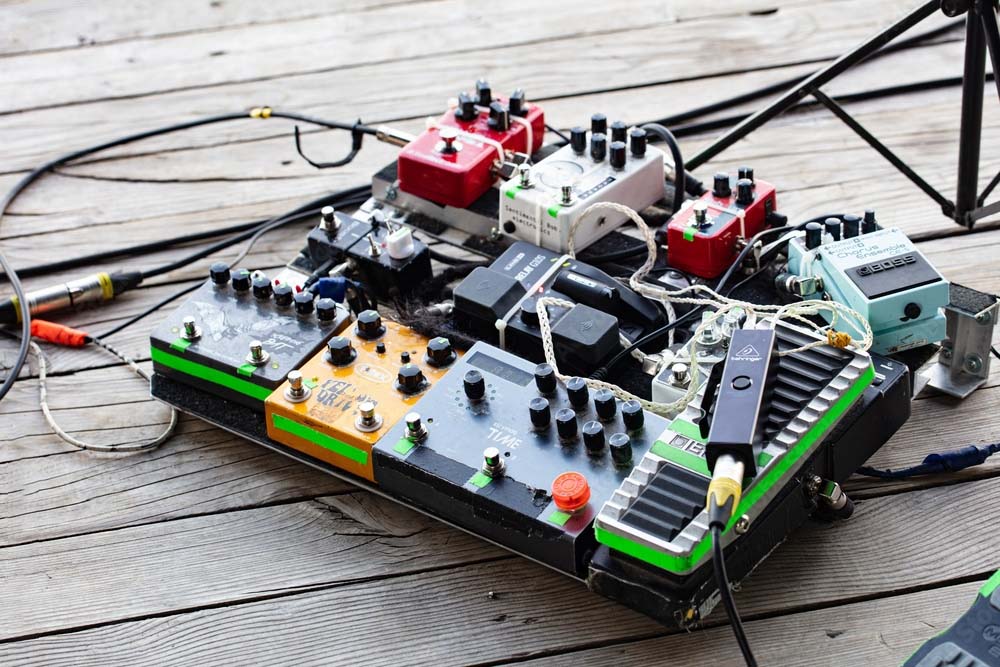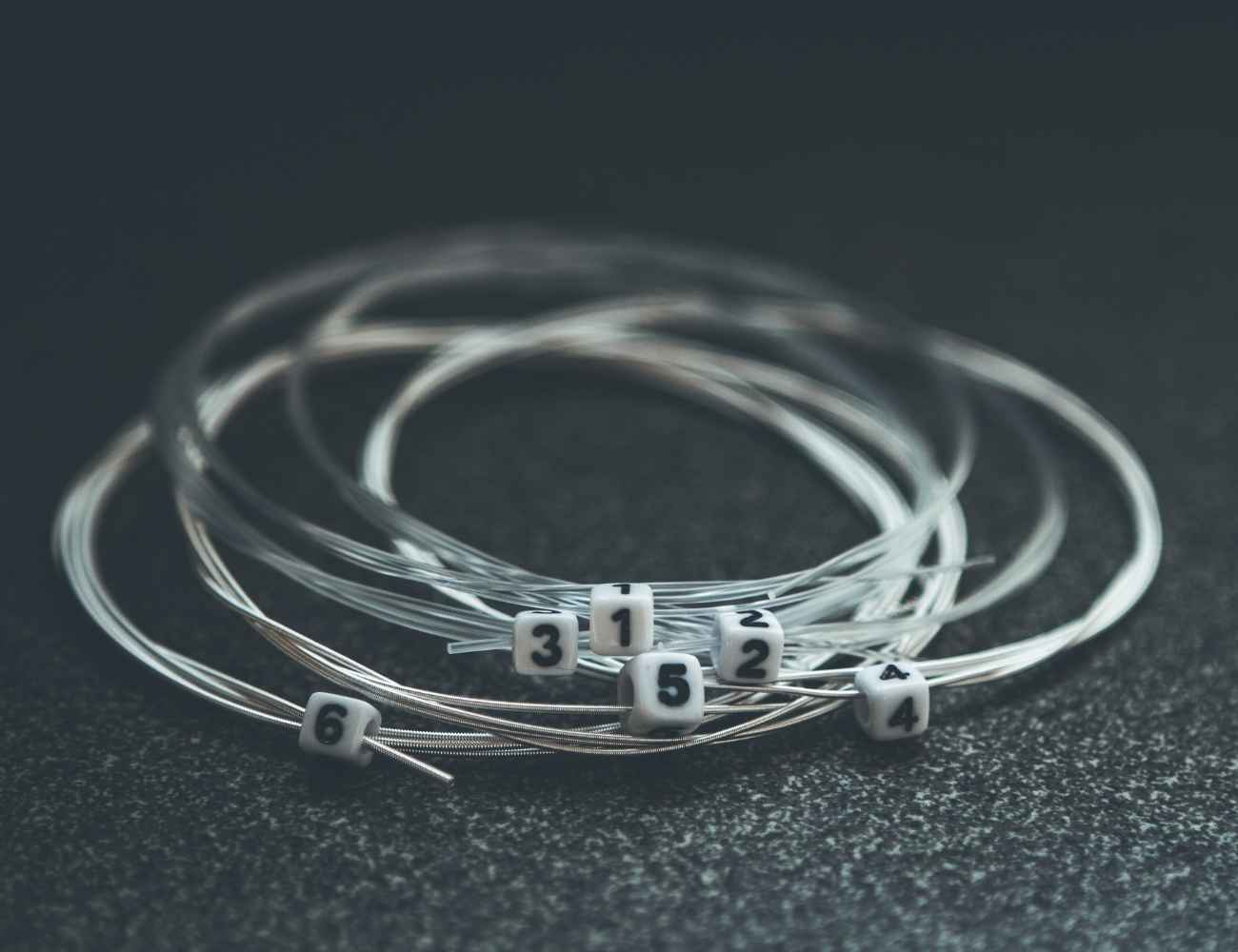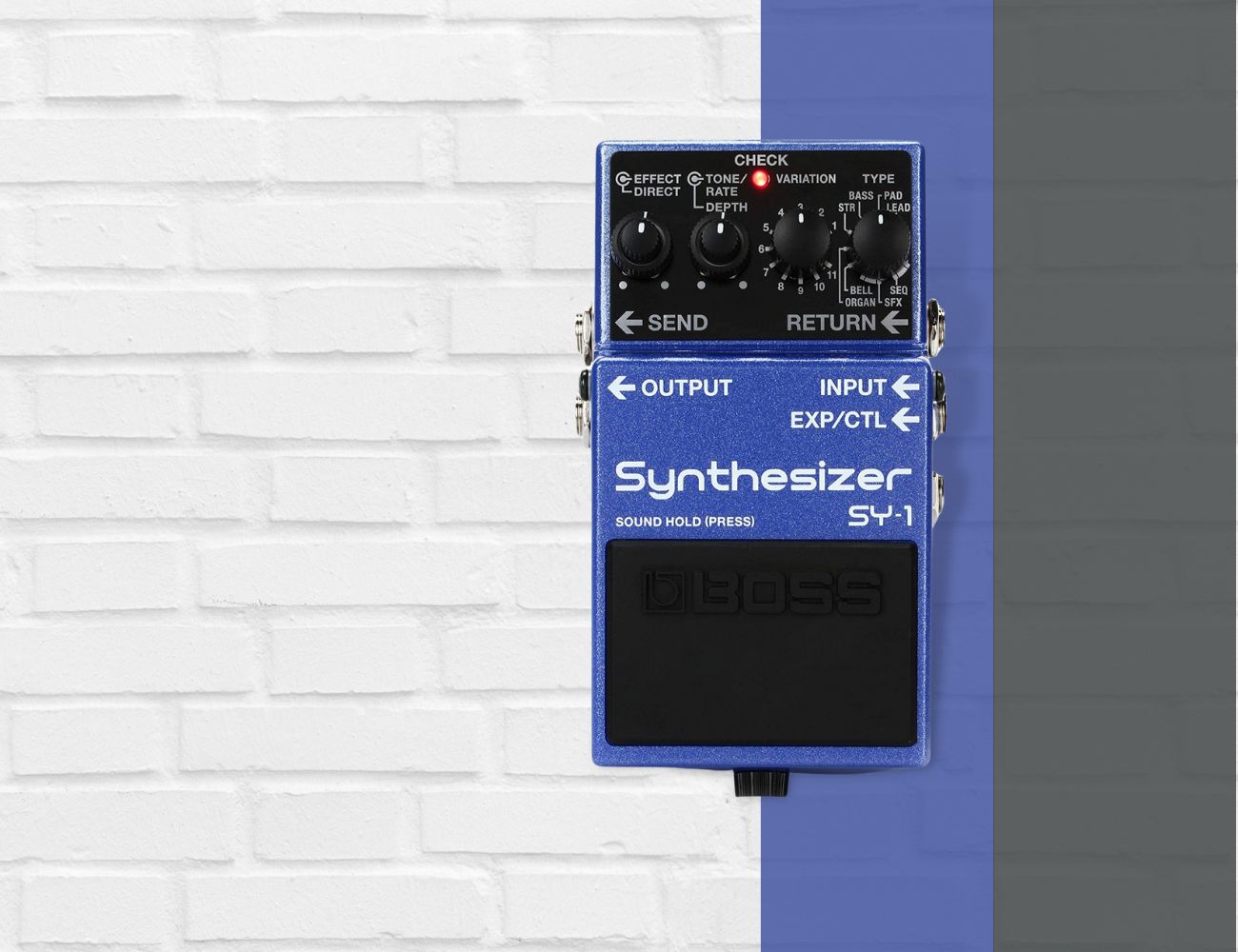Ever felt like your guitar’s character limits your experimental playing?
Say goodbye to those overly tamed single notes and harrowing limited range of tones, and let loose as you unleash a never-before-heard soundscape.
In this post, we’ll cover the remarkable world of pitch shifting pedals that will redefine your guitar playing.
These trusty additions to your pedalboard breathe new life into your arrangements and are unbelievably powerful and transformative by multiplying, shifting, and harmonizing the pitch of your original signal whenever and wherever you want.
Aside from that, I’ll also answer some of the most frequently asked questions on this topic so that you can have better knowledge when purchasing one in the future.
Table of Contents
- Best Pitch Shifter Pedals
- TC Electronic BRAINWAVES Pitch Shifter
- DigiTech Whammy 5th Gen Pitch-Shift Effect Pedal
- Boss PS-6 Harmonist Pedal
- Digitech Mini Pitch Acoustic Guitar Effect Pedal
- EarthQuaker Devices Rainbow Machine V2 Pitch-Shifting Pedal
- Alexander Pedals Superball Pitch Shifting Modulator Pedal
- Gamechanger Audio Third Distortion Pedal with Pitch Shifting
- Electro-Harmonix Pitch Fork Pedal
- MOOER Pitch Box Guitar Harmonizer Pedal
- Eventide PitchFactor Harmonizer Guitar Effects Pedal
- DigiTech Whammy Ricochet Pitch Shifting Guitar Effects Pedal
- MOOER Pitch Step Expression Guitar Pedal
- MXR Blue Box Octave Fuzz Pedal
- Red Panda Raster 2 Delay Pedal with Pitch Shifting
- DigiTech DROP Compact Polyphonic Pitch-Shifter Pedal
- What exactly is a pitch shifting pedal?
- What to consider when choosing a pitch shifting pedal?
- How to properly use a pitch shifting pedal?
- – Familiarize yourself with the controls and features:
- – Adjust the parameters to suit your musical goals
- – Incorporate the pitch shifting pedal into your signal chain
- – Test the pedal in various performance settings
- – Experiment with different musical styles and applications
- – Combine the pitch shifter with other effect pedals
- – Refine your pitch shifting technique
- How to order pedals on a pedalboard?
- Boutique vs. Mass-Produced pedals
- How much should you spend on a guitar pedal?
- Can you use a guitar pedal with a bass guitar?
- How to properly power your pedals?
Best Pitch Shifter Pedals
Before I begin, here are my top selected choices:
Digitech Mini Pitch Acoustic Guitar Effect Pedal

Classic Whammy pitch shifting with customizable rise and fall time. Check Price
|
|
MOOER Pitch Box Guitar Harmonizer Pedal

16 parameters, true bypass, and small, exquisite design. Check Price
|
TC Electronic BRAINWAVES Pitch Shifter
Studio-grade pitch shifting with MASH footswitch and dual voices.
This pitch shifting pedal features a pressure-sensitive footswitch, allowing for dynamic control over the effect parameters. With its intuitive interface and advanced algorithms, the pedal provides studio-grade sound quality and a wide range of shifting options.
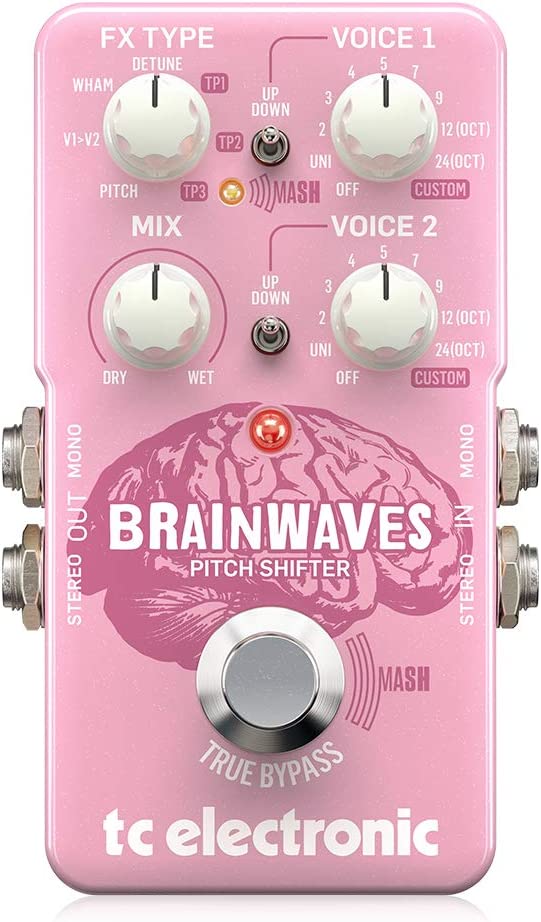
This TC Electronic BRAINWAVES PITCH SHIFTER is a phenomenal compact-style pedal with unique features.
As the name suggests, it’s a sophisticated tool, brimming with studio-grade algorithms, that transforms your guitar tone by shifting its pitch.
As a result, it’s an ideal device for musicians experimenting with sound layers and tone variations.
A key feature, the MASH footswitch, stands out due to its innovative pressure-sensitive design.
It reacts to the intensity of your foot pressure, allowing you to control and modulate effects in real-time, offering a dynamic and immersive playing experience.
Although compact, the pedal’s dimensions (4.72 x 1.97 x 2.91 inches) and weight (310 grams) ensure it is robust and can handle rigorous use.
With a 9-volt power supply, it is energy-efficient as well.
Sporting a standout pink hue, this pedal isn’t just about practicality; it’s a statement piece on any pedalboard.
- My Review
First off, the look and feel of this TC Electronic BRAINWAVES PITCH SHIFTER struck me immediately.
There’s a certain aesthetic appeal to it.
It’s got this vibrant pink hue that’s hard to ignore, and at the same time, it screams professional-grade equipment.
I should tell you, there’s nothing ‘basic’ about this pedal.
Its functionalities go beyond merely adding bass tracks – this is a sound transformation powerhouse.
I was particularly drawn to its pitch shifting ability.
With this pedal at your feet, a wide world of tonal experimentation is just waiting to be explored.
It’s compact yet robust. I loved the feel of its weight – just 310 grams, but it has a presence.
Even more impressive is its dimensions – it’s only 4.72 x 1.97 x 2.91 inches but packs a punch like no other.
Here’s something cool – it runs on 9 volts, so energy efficiency is a plus.
But don’t let its power requirement fool you; it delivers, and how!
Now, let’s talk about the MASH footswitch.
This is no ordinary footswitch; it’s pressure-sensitive.
It’s not every day you find such a smart feature.
Apply more pressure, and you get more of the effect – it’s a dream for anyone who loves manipulating sounds.
But, it’s not all praise from me.
I felt the lack of clear instructions was a miss.
This is not a product for beginners, and it took a bit of tinkering to figure out.
Here are the ratings I’ll give to the TC Electronic BRAINWAVES Pitch Shifter:
However, once you get the hang of it, this little beast opens up a new realm of sonic possibilities.
All in all, I believe the BRAINWAVES PITCH SHIFTER, with its unique capabilities and innovative design, truly stands out in the world of guitar pedals.
- Pros:
- Exceptional pitch shifting capabilities.
- Studio-grade algorithms for high-quality sound.
- 4 octave dual voices for versatile performance.
- Innovative pressure-sensitive footswitch.
- Cons:
- Artificial and unnatural pitch shifting.
- Inconsistent performance of the MASH footswitch.
- Build quality feels cheap.
- Tracking issues and mediocre sound quality.
My final verdict is that the TC Electronic BRAINWAVES PITCH SHIFTER falls short of expectations.
While it offers some notable features like exceptional pitch shifting capabilities, studio-grade algorithms, and a unique pressure-sensitive footswitch, it suffers from issues such as artificial and unnatural pitch shifting, inconsistent performance of the MASH footswitch, and mediocre sound quality.
In addition, the build quality also seems to be a concern.
Considering these factors, the overall value and performance of the product may not meet the expectations of users seeking a high-quality pitch shifter.
Therefore, exploring alternative options that offer better tracking, sound quality, and overall reliability is recommended.
DigiTech Whammy 5th Gen Pitch-Shift Effect Pedal
Revolutionary pitch shifting with true bypass and MIDI input.
Digitech Whammy pedal gives guitarists the ability to create unique sound effects, from subtle pitch bends to wild dive bombs. Comes with a power supply for easy setup, and is in lightly used condition.
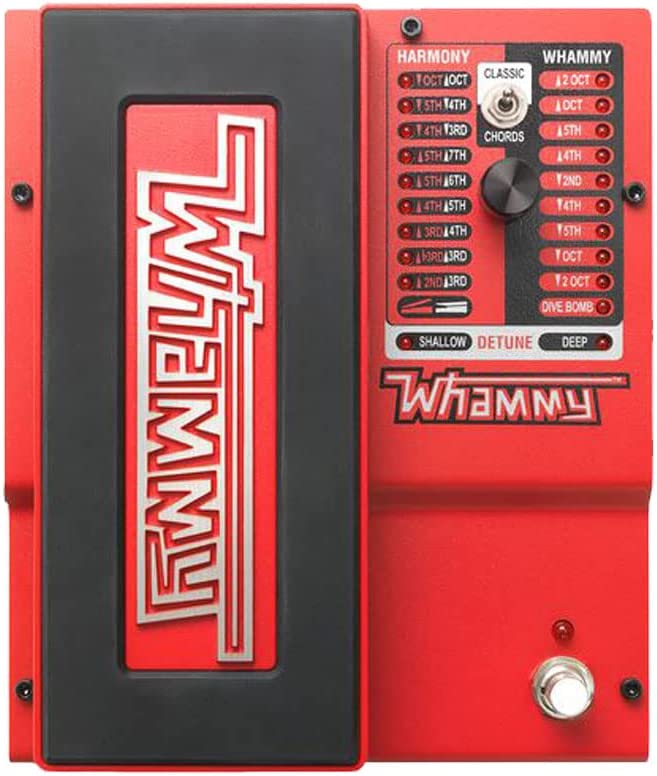
The DigiTech Whammy, a fifth-generation model, is a compact effect pedal that stands out in a vibrant red hue.
This nifty gadget is designed to manipulate the pitch in two distinct modes, making it a versatile tool for musicians.
Built with True Bypass, it ensures your signal’s integrity by preventing signal loss or coloration when the pedal is disengaged.
The Whammy also accommodates MIDI inputs, providing greater control over your music and making it compatible with a wide range of audio equipment.
Although gently used, it still functions perfectly and comes complete with its power supply.
It operates on a standard 9-volt power source to keep things simple and efficient.
Don’t be fooled by its compact design, measuring 10.6 x 8.1 x 2.6 inches; it leaves plenty of space for your other pedals while packing a hefty punch in terms of performance.
It’s a high-tech gadget cleverly fitted into a small, stylish package.
- My Review
Stepping on the DigiTech Whammy for the first time, I immediately felt a surge of inspiration flow through my fingers.
As a 5th Gen model, it brilliantly manifests two pitch shifting modes, offering a world of exploration.
Packed into this vibrant red, compact pedal, it’s not only aesthetically pleasing but also packs a wealth of tonal variety that I found indispensable.
My fascination peaked when I began to understand the True Bypass feature.
It’s a smart functionality that maintains the integrity of my signal even when the pedal is switched off – talk about attention to detail!
Moreover, as a device that works flawlessly on just 9 volts, I found it to be impressively energy-efficient without compromising performance.
One of the things that really stands out is its compatibility with MIDI inputs.
It takes this pitch-shifting pedal to the next level, allowing for a broader spectrum of audio possibilities.
Such a feature places it in the higher echelons of versatile pedals, expanding its uses beyond my initial expectations.
Despite its previous light use, it worked like a charm, with no hiccups whatsoever, with the provided power supply ensuring seamless operation.
It left me wondering how such a compact package, neatly fitting into my pedalboard with dimensions of 10.6 x overall, the Digitech Whammy redefined my expectations of what a pedal can achieve.
Its MIDI compatibility, pitch shifting abilities, and thoughtful design set it apart.
Here are the ratings I’ll give to the DigiTech Whammy 5th Gen Pitch-Shift Effect Pedal:
While it’s an investment, I found it worth every cent, and I can’t wait to see what new sounds I can coax out of it in the future.
The Digitech Whammy isn’t just a pedal; it’s a tool that invites me to push my musical boundaries further than I ever thought possible.
- Pros:
- Wide pitch-shifting capabilities.
- Compact and portable design.
- True bypass for clean signal.
- Cons:
- Limited control options.
- May require additional power supply.
My final verdict is that the DigiTech Whammy (5th Gen) 2-Mode Pitch-Shift Effect Pedal is a versatile and feature-rich pedal that delivers excellent tone and performance.
With its wide pitch shifting capabilities and compact design, it offers convenience and flexibility for musicians.
The true bypass feature ensures a clean signal, and DigiTech is known for producing quality musical equipment.
Boss PS-6 Harmonist Pedal
Super Bend mode, 3-voice harmony, pitch shifter, and expression pedal control.
The BOSS HARMONIST offers four intelligent pitch-shift effects and three-voice harmony, plus optional expression pedal control. It’s easy to create rich, three-voice harmonies with major and minor key choices and three-voice shift settings.
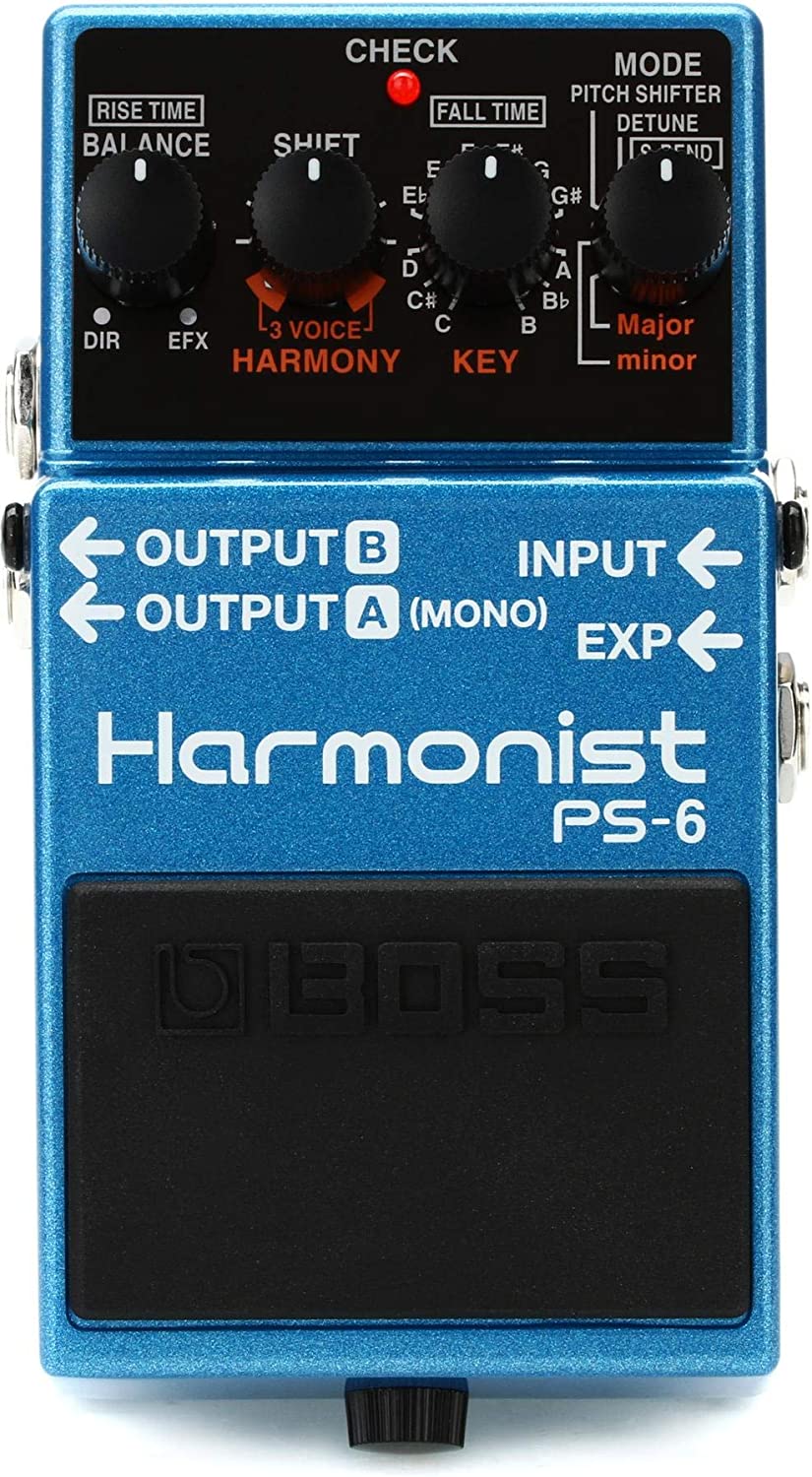
Let’s dive into the heart of the Boss PS-6 Harmonist Pedal.
At first glance, you’ll be struck by its vibrant blue shell – a sturdy, compact piece that comfortably fits into your gear setup.
Weighing just a tad over a pound, it won’t be a burden to your rig.
Its dimensions are also quite compact, at about 6 by 3.85 by 2.7 inches.
But let’s get to the real treasure here: the features.
This pedal packs a punch with three-voice guitar harmony effects and a pitch shifter.
In addition, you can control the pitch with an optional expression pedal, giving you great flexibility on stage.
A standout feature is the Super Bend, also known as the S-BEND.
It’s responsible for creating unique sounds, enabling pitch sweeps ranging from three to four octaves.
There’s also a detune mode for extra sonic experimentation.
What makes this pedal special is its intelligent pitch-shift effects.
It’s user-friendly and promises superior sound quality, all in one compact blue box.
Whether major or minor keys, this pedal offers a range of interval patterns.
By selecting the shift to 3-voice, you can effortlessly generate rich, three-voice harmony.
- My Review
Taking the Boss PS-6 Harmonist Pedal for a spin was an exciting venture.
Every pluck of a string brought forth a myriad of sounds, showcasing the pedal’s remarkable range.
Its vibrant blue exterior may catch your eye, but the innards make it stand out.
Even though it doesn’t occupy much physical space, its impact on your sound is colossal.
The three-voice guitar harmony effects were a game-changer for me, elevating my melodies to new heights.
In addition, manipulating pitch on the fly with an optional expression pedal introduced a refreshingly liberating flexibility.
The PS-6 wasn’t just about the harmony, though.
Switching to the Super Bend mode, or S-BEND as it’s fondly referred to, unlocked a new dimension of sound.
What captivated me was how the S-BEND allowed sweeping pitch shifts, traversing three to four octaves.
I felt like a sound architect constructing these expansive sonic landscapes.
And the detune mode added an unexpected yet delightful touch, allowing me to create more experimental and intricate soundscapes.
But let’s talk about user-friendliness.
The intelligent pitch-shift effects were a dream to work with.
Selecting a shift to 3-voice provided such rich, three-voice harmony that I felt like I had a backing choir in the pedal.
Even when dabbling in major or minor keys, I was thrilled by the range of interval patterns at my disposal.
Now, the pedal isn’t without its quirks.
Here are the ratings I’ll give to the Boss PS-6 Harmonist Pedal:
It took me a moment to find my footing, especially with the S-BEND, but the sky was truly the limit once mastered.
My takeaway? The Boss PS-6 Harmonist Pedal is more than just a pedal – it’s a tool that elevates your music and helps you break boundaries.
- Pros:
- Versatile harmonies and pitch effects
- Good sound quality and tracking
- S-Bend mode for divebomb effects
- Allows for three-voice harmonies
- Compact size and fits well on pedalboards
- Cons:
- Some users find it difficult to dial in desired effects
- Harmony function may not stay in key consistently
- Limited usefulness in live performances
- Issues with durability reported by some users
- Customer support may be lacking
My final verdict is that the Boss PS-6 Harmonist Pedal is a versatile and feature-rich pedal that offers a range of harmonizing and pitch shifting effects.
However, while it has received positive reviews for its sound quality and the S-Bend mode, there are some limitations and issues reported by users, such as difficulty dialing in effects and concerns about durability.
Considering its brand reputation and overall value, it can be a worthwhile addition to a guitarist’s pedalboard.
However, it may require experimentation and careful consideration of individual needs and preferences.
Digitech Mini Pitch Acoustic Guitar Effect Pedal
Classic Whammy pitch shifting with customizable rise and fall time.
The WHAMMY RICOCHET offers classic whammy pitch shifting and unique sounds through momentary footswitch control and adjustable Rise and Fall time ballistics. It has seven pitch selections and a toggle to select up or down for the selected pitch.

DigiTech’s compact Whammy Ricochet is a pitch shifting guitar effect pedal packed in a robust red casing.
It stands out because it offers that sought-after Whammy effect without requiring a large treadle.
This compact device allows you to bend your guitar notes up or down across a two-octave range, giving you incredible control over your sound.
This pedal is particularly versatile, offering seven pitch intervals for selection and granting you ultimate control over Shift and Return time.
In addition, its interactive LED Trajectory Ladder is a handy feature for real-time visual feedback on your pitch shifts.
It’s an unobtrusive addition to your gear setup, measuring 4.75 x 2.88 x 1.75 inches and weighing just 0.4 pounds.
This Whammy Ricochet pedal delivers traditional whammy pitch shifting and explores new sonic territories.
It’s a handy little companion for those seeking to push their creativity to new boundaries.
- My Review
You know, this DigiTech Whammy Ricochet pedal is a little dynamo.
It’s compact and well-built, fitting snugly into any pedalboard setup.
From a usability standpoint, the size of this thing is a real winner, and it doesn’t compromise the iconic Whammy sound.
Playing around with it, the Ricochet gave me various pitch shifting options.
Whether it’s a subtle shift for a 12-string effect, a dive bomb for that heavy metal sound, or a full two-octave shift for creative solos, this pedal can do it all.
Its seven selectable pitch intervals provided a wealth of sonic possibilities.
I found myself experimenting and stumbling upon entirely new sounds, which does not happen with every pedal.
Interestingly, its unique footswitch design replaces the bulky treadle, offering the same whammy action in a much simpler way.
Just press and hold – it’s that easy.
I could set the rise and fall time ballistics as I wanted, adding a new dimension to my pitch bending.
However, it wasn’t all sunshine and rainbows.
I noticed that when used as an octave, especially for higher notes, the Ricochet didn’t maintain the clarity of tone I hoped for.
Also, the momentary switch seems a tad buggy, occasionally producing an unpleasant ground buzz.
Despite these minor gripes, the Ricochet is a solid addition to my setup.
Here are the ratings I’ll give to the Digitech Mini Pitch Acoustic Guitar Effect Pedal:
Its innovative design, functionality, and the Whammy effect’s classic charm make it a worthwhile companion for any guitarist.
Just be mindful of its limitations and keep a 300mA power supply handy – it’s a bit of a power hog, and you won’t want it running out of juice mid-jam.
- Pros:
- Versatile and compact size
- Immediate response with no lag
- Simulates 12-string guitar
- Dual function as whammy and octave pedal
- Well-made and durable
- Cons:
- May not be suitable as an octave pedal
- Some users experienced issues with functionality
- No auto engage feature
- Power supply not included
- Some color fading reported on B-stock units
My final verdict is that the Digitech Mini Pitch Acoustic Guitar Effect Pedal, Red (Whammy Ricochet), is a versatile and feature-packed pedal with a solid brand reputation.
It offers immediate response and customizable settings for pitch shifting, making it a valuable addition to any guitarist’s setup.
However, some users have reported functional issues, and it may not be ideal as an octave pedal.
Considering its overall performance and value, it earns a respectable score.
EarthQuaker Devices Rainbow Machine V2 Pitch-Shifting Pedal
Create wild sounds with the EarthQuaker Rainbow Machine V2 pedal.
The Rainbow Machine creates experimental sounds with modern DSP, offering real-time pitch shifting with digital oscillators. Perfect for experimenters, adventurists, and noisemakers, it’s not for those seeking natural sounds.
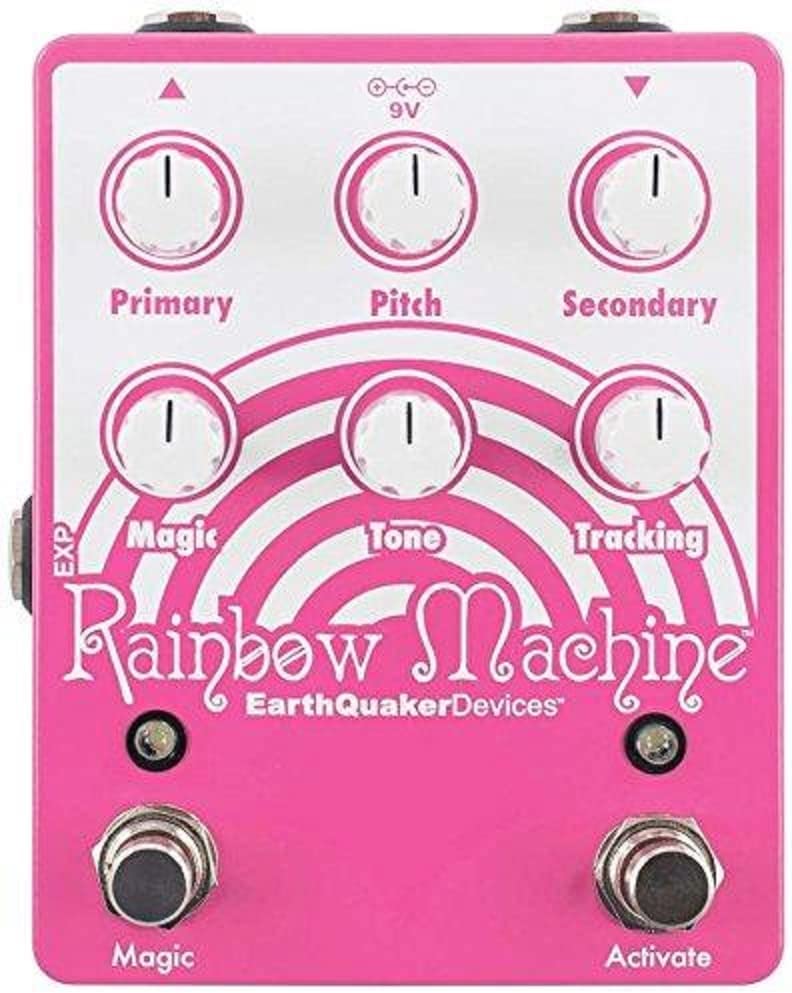
Allow me to paint a picture of the EarthQuaker Devices Rainbow Machine V2.
This unique device stands out as a pedal with polyphonic pitch shifting capabilities, setting it apart from traditional guitar effects pedals.
A truly adventurous piece of equipment, it allows musicians to dive into experimental soundscapes and synthetic textures.
With a bold pink and white color scheme, the device also carries a distinct visual appeal.
Sporting dimensions of 5.65 x 4.35 x 3.25 inches and a weight of 1.17 pounds, it’s a compact yet solid unit, easy to carry around or fit into any pedalboard setup.
Intricate controls, including Flexi Switch, Primary, Pitch, and secondary tracking, add flexibility and adjustability, making it a versatile tool for the adventurous musician.
Worth noting, however, is that it isn’t designed for creating natural sounds but rather focuses on real-time pitch shifting with digital oscillators, offering a unique sonic palette for the experimentalist.
- My Review
Jumping headfirst into the Rainbow Machine V2, I was enveloped in a cosmic soundscape, the likes of which I’d never before experienced from a guitar pedal.
It’s no understatement to say this isn’t your typical effects unit; this one caters to the bold, the experimental, and the fearless.
Admittedly, some may find it lacks the organic tones we’re accustomed to in traditional guitar pedals, but that’s part of its unique charm.
This isn’t a unit designed to replicate or produce ‘natural’ sounds.
Instead, it thrives in a synthetic universe, using digital oscillators for real-time pitch shifting.
As a result, it’s like nothing else on the market.
One of the standout features is the Flexi Switch, which adds a layer of control and versatility.
Despite the array of knobs and switches, it felt intuitive to operate.
With some tweaking, I could get from subtle, almost ethereal sounds to full-blown psychedelic vibes that would make any Pink Floyd fan smile.
It’s as if this pedal takes you on a sonic journey; each set is a different destination.
Durability is a clear strength of the Rainbow Machine.
It feels robust and well-built.
There’s a sense of quality and craftsmanship that reinforces the investment.
But the icing on the cake is surely its aesthetics.
The pink and white finish feels bold and eye-catching, matching its unique sonic output.
That being said, the Rainbow Machine won’t suit everyone.
It leans more toward the avant-garde and isn’t quite the workhorse that a more traditional chorus or delay pedal might be.
Here are the ratings I’ll give to the EarthQuaker Devices Rainbow Machine V2 Pitch Shifting Pedal:
It’s also not the most affordable pedal on the market.
But for those seeking something different, a pedal that dares to push boundaries and inspires creativity, it’s hard to overlook the Rainbow Machine V2.
- Pros:
- Unique and special effects
- Variety of modulations
- Ethereal to psychedelic sounds
- Well-built and visually appealing
- Cons:
- Some sounds may be unpleasant
- May have limited applications
- Relatively expensive
My final verdict is that the EarthQuaker Devices Rainbow Machine V2 Polyphonic Pitch Shifting Modulator Pedal is a unique and versatile pedal offering various experimental and unconventional effects.
With its variety of modulations, well-built construction, and visually appealing design, it has the potential to add interesting elements to your music.
However, it’s important to note that some users have found certain sounds produced by the pedal unpleasant, and its applications may be somewhat limited for certain musical styles.
Nevertheless, considering its relatively higher price point, it’s recommended for those who value its distinct features and are looking to explore new sonic territories.
Alexander Pedals Superball Pitch Shifting Modulator Pedal
Modulate Everything with realistic rubber ball physics.
Superball is a powerful digital delay effect with an LFO, time sequencing, and resonant low-pass filter for creating bouncy oscillations. Unleash your creativity and explore an infinite range of possibilities for sound design.
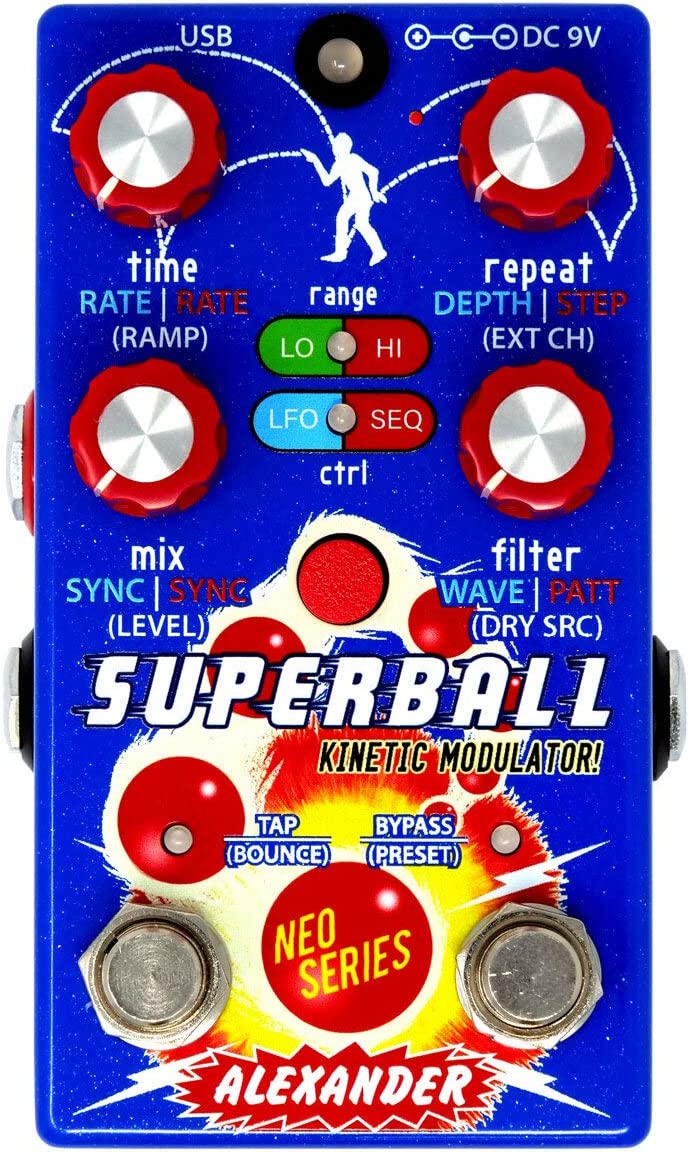
Alexander Pedals Superball is an exceptional blend of a delay and filter pedal, boasting a unique approach to sound modulation.
It’s a feature-packed piece of gear, allowing you to harness the magic of its versatile low-frequency oscillator, influencing each aspect of the delay effect.
For example, the oscillator can sync with tap tempo or mimic the bounce of a ball, adding a twist to your sound.
Superball doesn’t stop there.
With its step sequencer, you can manipulate the delay clock for intriguing pitch shifting and time-stretching outcomes.
In addition, it offers built-in patterns, individual step control, and even the ability to input your sequences via MIDI.
This device exhibits impressive flexibility with its footswitch, which can be configured for precise control over delay time, LFO speed, or sequencer rate.
The select button, serving as a functional mastermind, makes the four knobs quadruply effective, offering a level of hands-on control that’s hard to rival.
Remember, the pedal can store four favorite settings for easy recall.
Beyond these highlights, Superball functions with 9 volts and 300 milliamps, using knob-style controls.
- My Review
Exploring the capabilities of Alexander Pedals’ Superball was like diving headfirst into an ocean of sonic possibilities.
My first impression, and something I quickly realized, was the sheer flexibility this pedal affords you.
With its multitude of functions, it immediately struck me as an experimental wonderland for adventurous sound seekers.
The low-frequency oscillator, a significant highlight, offered an impressive range of control over the delay effect.
Whether syncing it with the tap tempo or simulating a bouncing ball, each choice birthed a distinct soundscape, leaving me grinning pleasantly.
Moreover, discovering how dramatically the sound could change with just a few tweaks was a joy.
As I dug deeper into its offerings, the step sequencer won me over.
Manipulating the delay clock to produce real-time pitch shifts and time-stretching effects felt like creating my unique rhythm language.
From following the built-in patterns to inputting my MIDI sequences, it was an exhilarating dance between me, time, and pitch.
The footswitch stood out in its ability to finely adjust delay time, LFO speed, or the sequencer rate.
I found this invaluable for spontaneous live performances, where precise control can make a difference.
A distinctive feature was the Select button.
Letting four knobs do quadruple duty felt like having the steering wheel of a sonic spaceship, giving me the power to sculpt my sounds in intricate detail.
Plus, saving up to four favorite settings was a welcome convenience.
However, while its multi-functionality is exciting, it does bring a slight learning curve, especially for those used to traditional stompboxes.
Nevertheless, I found that after some exploration and trial-and-error, I was able to harness its capabilities to create some genuinely remarkable sounds.
Here are the ratings I’ll give to the Alexander Pedals Superball Pitch Shifting Modulator Pedal:
Powered by 9 volts and operating at 300 milliamps, the Superball is a remarkable piece of gear, daring to be different in the best possible way.
Just remember, as its description warns, they’re not getting it down if you get it stuck on your roof!
- Pros:
- Unique and interesting sounds
- Knobs are multifunctional for versatile control
- Ability to save up to 4 settings
- Cons:
- Steep learning curve for optimal usage
- Can become overwhelming with multiple simultaneous sounds
My final verdict is that the Alexander Pedals Superball Pitch Shifting Delay/Filter is an impressive and versatile product with various unique and interesting sounds.
Its multifunctional knobs allow precise control over various pedal sound elements.
While there may be a learning curve to fully utilize its features, the ability to save up to four settings adds convenience.
Although no negative reviews are available now, it’s important to consider that the pedal’s multiple simultaneous sounds might be overwhelming for some users.
But overall, the brand has a positive reputation, and the product’s value appears reasonable.
Gamechanger Audio Third Distortion Pedal with Pitch Shifting
Revolutionary distortion with electric discharges, captivating visuals and noiseless performance.
The PLASMA Coil provides a unique distortion sound and visual experience by converting your instrument’s signal into a series of high voltage plasma discharges in a sealed xenon filled tube. This pedal also acts as a noise gating device, eliminating all unwanted noise and pickup hum.
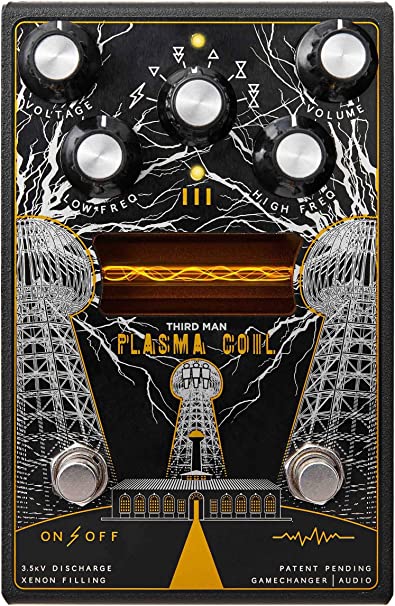
Take a look at Third Man’s thrilling PLASMA Coil, a sound tool with electrifying capabilities.
Although this is no regular distortion pedal, it’s a marvel of sound engineering in collaboration with the iconic Jack White.
With it, your musical signal morphs into powerful high-voltage plasma discharges within a xenon-filled tube.
The result? Sharp, sizzling overdrive effects like no other.
This pedal provides a wide range of picking responses, and you can toggle between 6-octave effects for diverse sound outputs.
It’s important to note that it doesn’t include a power supply – you’ll need a standard 9V DC one.
Remember, it’s a weighty little gadget, clocking in at 1 pound, and the clear and white design will stand out on your pedalboard.
Besides the stunning aesthetic, the visible lightning bolts react to your playing, making it a real show-stopper.
Truly, the PLASMA Coil offers a whole new way to manipulate your guitar’s output, promising unique, distortion-rich sounds.
- My Review
Diving right into this, the Gamechanger Audio Third Man Records PLASMA Coil High Voltage Distortion Effect Pedal – what a mouthful – is quite an intriguing gadget.
Distinctive, robust, and not for the faint-hearted.
My first impression? It’s aggressive, a rebel on the distortion field.
Its ability to convert instrument signals into high-voltage plasma discharges is astounding.
Seriously, you’re harnessing a bolt of electricity in a neat pedal package.
From soft, sputtery sounds to blistering, sharp sustains, my picking echoed in vivid and unique tonal variations.
Flipping the octave switch added another level of insanity to the mix, spitting out a rage of fuzz sounds.
Speaking of fuzz, the way the PLASMA Coil dominates this sound effect is unparalleled.
Expanding on the wonders of the PLASMA Coil, its pitch shifting capabilities deserve a special mention.
These are not your run-of-the-mill octave effects.
Instead, with a twist of a knob, your sound ascends or descends into new territories, creating these gritty, glitchy soundscapes.
Whether aiming for bit crush-style subharmonics or Octafuzz-style upper harmonics, the pedal delivers an audacious punch.
Even more thrilling are the mixed modes that layer upper and lower harmonics together, resulting in complex and downright unpredictable outputs.
Every strum is an invitation to experiment, push the boundaries, and plunge into this sound vortex.
But here’s something that surprised me, the noise-gating effect.
While playing, I noticed that unwanted noise and pickup hum was virtually eliminated.
Silences were true silences.
Such precision is appreciated, allowing the focus to remain on each note, sharp as a tack.
While exploring Jack White’s custom settings, I was met with what could only be described as controlled chaos.
Every twist and turn of the knob opened up another dimension of sound, teasing out the wild beast within this pedal.
Yet, the journey through this sonic landscape wasn’t without its bumps.
One thing I struggled with was the power supply.
You’d think such a hefty price tag would include one, but you’ve got to source that separately.
And, just a heads up, the power supply connection can be a little finicky, so do your research before buying one.
Despite that minor annoyance, this PLASMA Coil left a lasting impression.
It’s a testament to the wild, untamed spirit of distortion.
Here are the ratings I’ll give to the Gamechanger Audio Third Distortion Pedal with Pitch Shifting:
Not your everyday pedal, it’s a journey, an experience, a game-changer.
For those brave enough, it’s a ride worth taking.
- Pros:
- Unique and aggressive octafuzz sounds
- Highly responsive to the player’s playing
- High-quality build and craftsmanship
- Offers a wide range of effects
- Replicates sounds from Jack White’s music
- Cons:
- May be limited in versatility for chords
- Some settings may result in excessive noise
- Not considered highly musical by some users
My final verdict is that the Gamechanger Audio Third Man Records PLASMA Coil High Voltage Distortion Effect Pedal is a unique and powerful pedal that offers various effects and delivers aggressive octa-fuzz sounds.
It excels in responsiveness, build quality, and replicating tones from Jack White’s music.
However, it may have some limitations in versatility for chords and could produce excessive noise in certain settings.
Nevertheless, considering the overall performance, features, and brand reputation, it offers good value to those seeking a distinctive, high-quality distortion pedal.
Electro-Harmonix Pitch Fork Pedal
Expressive pitch shifting with glitch-free tracking.
Polyphonic Pitch Fork pedal shifts 6-string guitar up to 3 octaves, providing glitch-free tracking, expression pedal control, and dry volume control for harmony effects. Use with an effects pedal for synth-like tones and gritty lows.
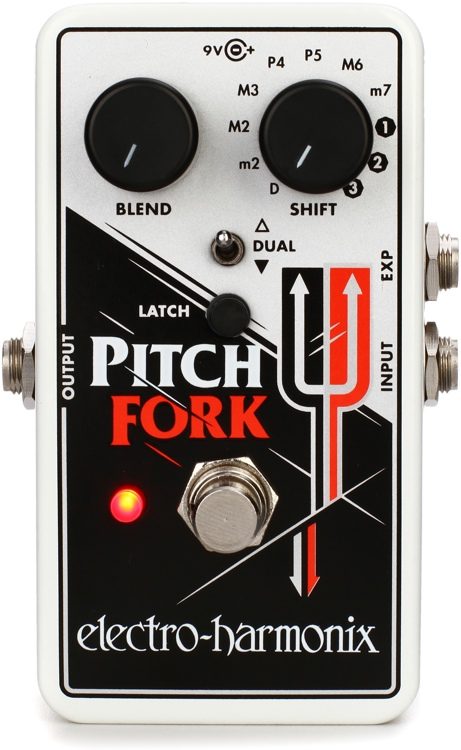
The Electro-Harmonix Pitch Fork is a compact, battery-powered, analog pitch shifter pedal that can significantly enhance your guitar’s sound.
With its polyphonic pitch shifting capabilities, the Pitch Fork can transform a 6-string guitar into a 12- or 18-string guitar or even create unique, synth-like tones without glitches.
In addition, the pedal works seamlessly with guitars and basses, allowing you to expand your sonic palette to new levels.
You can choose single-note pitch shifting or dual note (one up and one down) to adjust the range by +/- three octaves while playing at any speed.
Connecting an expression pedal gives you real-time control over pitch shifting and glissandi.
And with the dry volume control, you can easily blend in your original signal for harmonious effects.
Switch between latch or momentary modes to determine how the footswitch and expression pedal respond.
Rest assured that your signal path remains intact, thanks to the pedal’s true bypass feature.
Operate it using a 9V battery or the provided 9.6DC-200 power supply.
- My Review
Having used the Electro-Harmonix Pitch Fork pitch shifter pedal, I was immediately impressed by its uncomplicated design and easy-to-understand control layout.
Upon plugging it into my setup, I noticed significant improvements in my guitar’s sound, opening up many incredible tonal possibilities.
What I appreciated most about the Pitch Fork was its ability to turn my 6-string guitar into a 12- or 18-string guitar.
This functionality allowed me to create marvelous soundscapes and broaden my playing techniques.
In addition, thanks to its glitch-free tracking capability, I could also achieve unique synth tones without any frustration.
The option to switch between single note pitch shifting and dual note pitch shifting came in handy, giving me sufficient control to dial in almost any interval difference I wanted.
Integrating an expression pedal-enabled real-time pitch control and glissando adjustments was another valuable component I enjoyed.
The Pitch Fork’s dry volume control lets me produce effective harmony sounds by blending my original signal.
And toggling between latch and momentary modes allowed tailoring the way my footswitch and expression pedal responded, ensuring precise sound customization.
Throughout my experience, what remained essential was sound quality protection.
Thankfully, the true bypass feature preserved the integrity of my signal path.
Some may have found a minor gripe: the pitch range, although +/- three octaves could potentially provide broader range options.
However, it was never an issue during my time with this pedal.
Here are the ratings I’ll give to the Electro-Harmonix Pitch Fork Pedal:
The Electro-Harmonix Pitch Fork pedal stands out for its ease of use and incredible tonal possibilities, bringing a whole new realm of sound that transformed my playing experience.
This pedal has provided more than I could have ever asked for, and I would recommend it to any avid guitarist seeking to expand their sonic horizons.
- Pros:
- Expand guitar sound variety.
- Glitch-free pitch shifting.
- Expression pedal compatibility.
- Cons:
- Limited pitch range options.
- Battery life may vary.
- Latching could be smoother.
My final verdict is that the Electro-Harmonix Pitch Fork pedal excels as an innovative and versatile pitch shifter, allowing users to expand their musical journey with its impressive features and performance capabilities.
In addition, its accessible design and reputable branding make it a meaningful investment for guitarists seeking to broaden their technique and tonal palette.
MOOER Pitch Box Guitar Harmonizer Pedal
16 parameters, true bypass, and small, exquisite design.
The MOOER Pitch Box is an innovative harmony pitch shifter and detuner that provides 16 optional parameters for a wide range of creative possibilities. It features true bypass switching and a small and exquisite design, making it ideal for pedalboard rigs. With its intuitive controls, you can easily create harmonies and detune your guitar with ease.
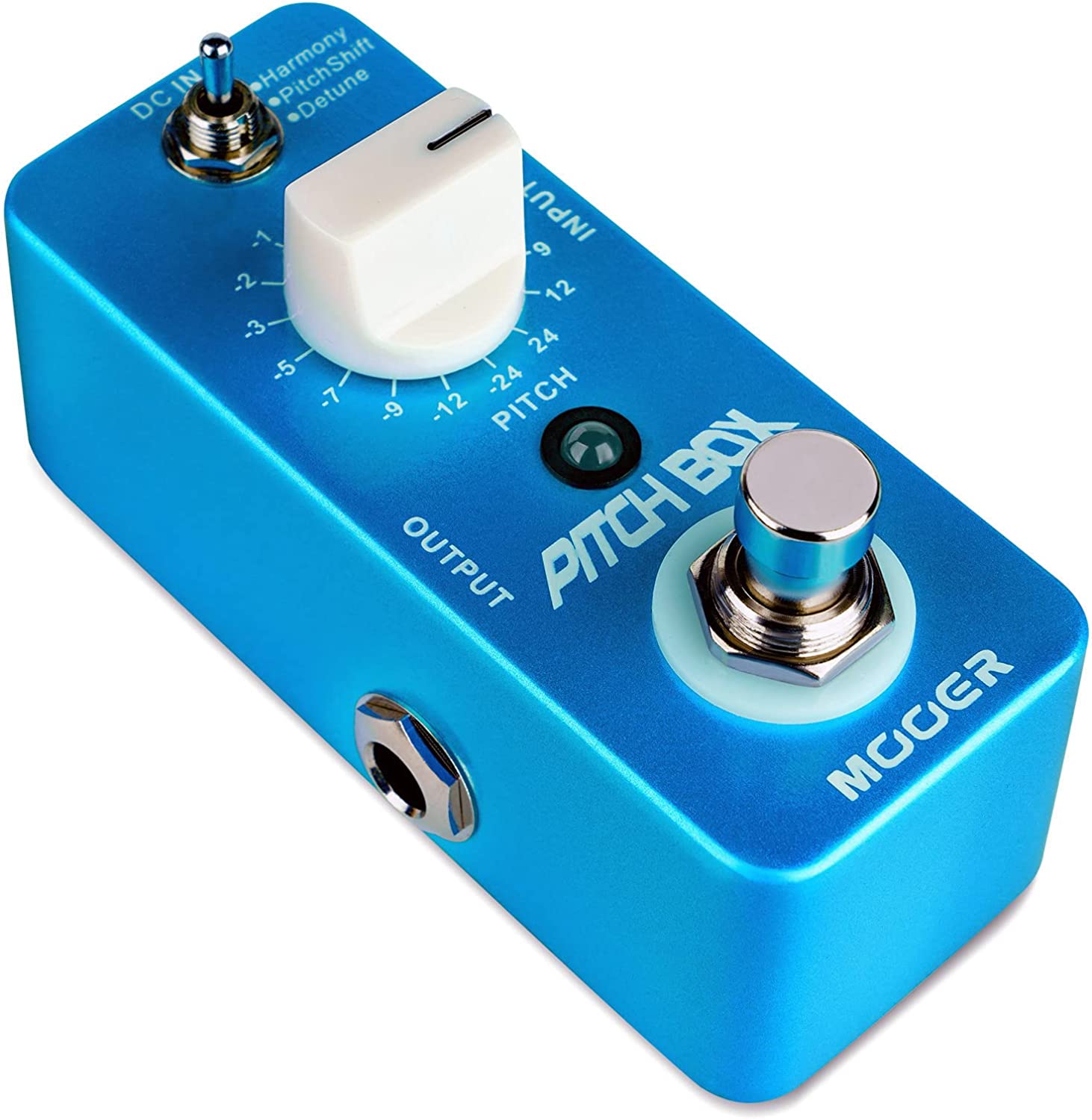
The MOOER Pitch Box is a compact guitar harmonizer pedal designed specifically for electric guitar and bass players who want to add depth and variation to their music.
This pedal allows users to shift between different pitch ranges from as low as -2 octaves to as high as +2 octaves, offering them 16 distinct tuning options to experiment with.
In addition, the pedal operates in three unique modes: Harmony, Pitch Shift, and Detune, each providing a different sonic experience.
One of the outstanding features of this pedal is its precise polyphonic pitch shifting capability, which ensures accurate and clear sound reproduction.
Fueled by a 9-volt AC adapter (not included) and housed in a durable full metal shell, the pedal is both lightweight (weighing 170 grams) and compact, making it an easy addition to any musician’s pedal board.
In addition, its true bypass switch allows for a seamless transition between effects without impacting the instrument’s natural sound when disengaged.
- My Review
Getting my hands on the MOOER Pitch Box guitar harmonizer pedal for the first time, I was immediately impressed with its compact and sleek design, fitting perfectly on my pedal board.
Weighing just 170 grams and encased in a full metal shell, this tiny pedal packs a serious punch.
One aspect that stands out is the wide array of tuning possibilities.
With three different modes – Harmony, Pitch Shift, and Detune – and a pitch range of ±2 octaves, I could experiment and create richer tones.
In addition, it offered a total of 16 distinct tuning options to play around with.
During practice sessions, mainly using the ‘detune’ function added significant depth to my sound – achieving a robust doubling effect.
The polyphonic pitch shifting was surprisingly accurate and clear considering the small pedal.
Simultaneously, I appreciated the true bypass feature, which ensured that the natural sound of my instrument remained pristine when the pedal was disengaged.
While exploring the capabilities of the MOOER Pitch Box, I discovered that the pedal works conveniently for both my electric guitar and bass sessions, turning out to be especially useful when adjusting to alternate tunings.
However, nothing is without shortcomings.
There was a mild hiss when engaged, but certainly manageable during a live performance.
Some digital artifacts and an almost imperceptible latency were also noticeable, but not to the degree that it would deter me from enjoying its functionality.
Here are the ratings I’ll give to the MOOER Pitch Box Guitar Harmonizer Pedal:
Considering everything, the MOO overall would cater well to the casual player or beginner guitarist seeking a cost-effective solution to broaden their sound options.
On the other hand, professional musicians looking for crystal-clear studio-worthy recordings may wish to explore higher-end options.
- Pros:
- Compact and lightweight design.
- Three modes and 16 tuning options.
- True bypass for preserving tone.
- Cons:
- Mild hiss when engaged.
- Noticeable digital artifacts at times.
- Almost imperceptible latency.
My final verdict is that the MOOER Pitch Box offers an impressive balance of affordability and versatility for players with varying needs.
The pedal satisfies those searching to add distinct tonal depth and experimentation to their music without breaking the bank.
However, professional musicians might seek higher-end options for studio-quality sound clarity.
Eventide PitchFactor Harmonizer Guitar Effects Pedal
Studio-quality pitch and delay effects.
The PitchFactor Harmonizer pedal provides access to 10 of Eventide’s greatest pitch-altering effects with adjustable wet/dry mix and MIDI control. It is compatible with a wide range of amps and foot pedals and can easily be upgraded via USB.
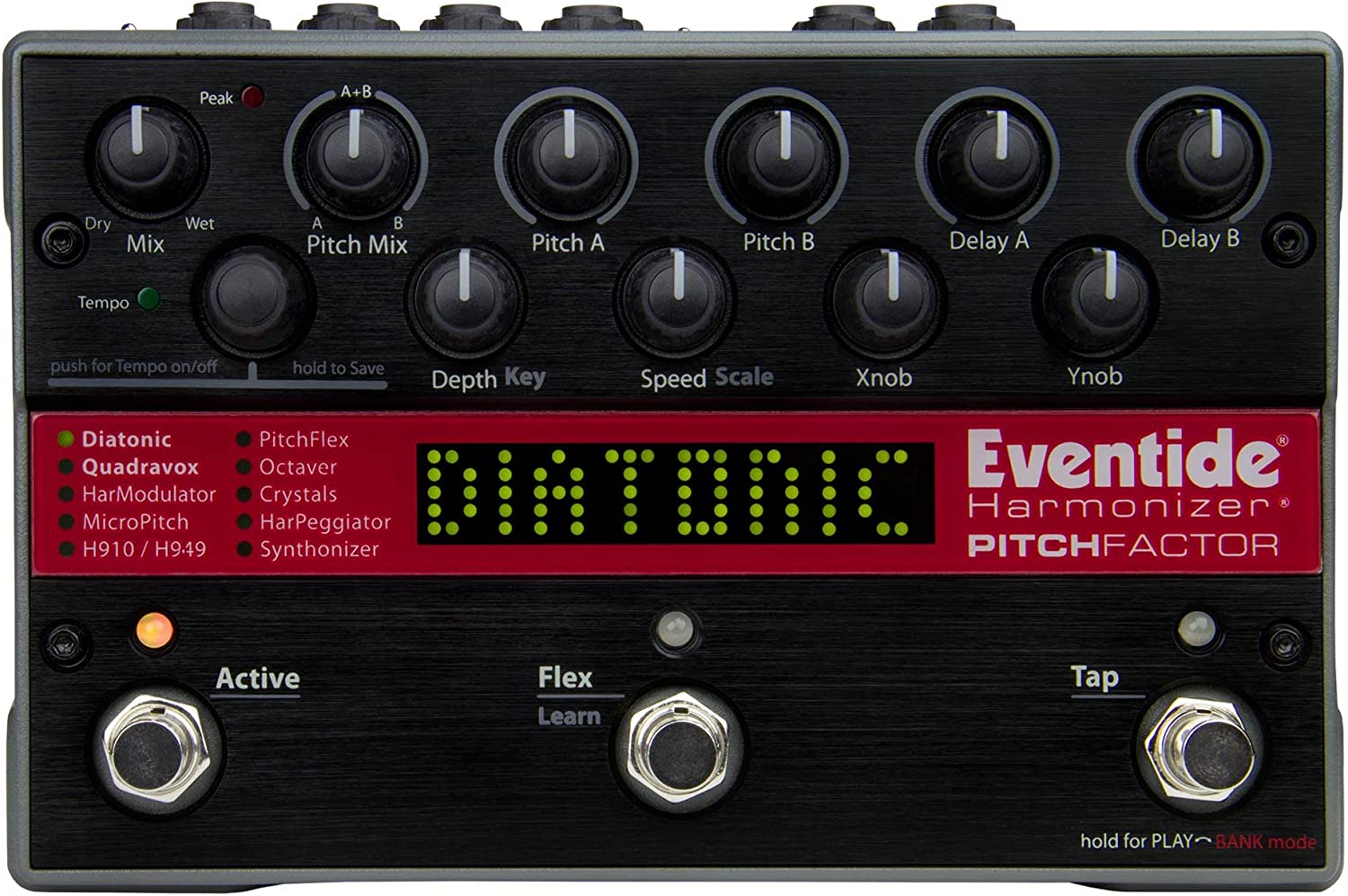
The Eventide PitchFactor Harmonizer Guitar Effects Pedal is a versatile, high-quality effects pedal for both guitar and bass players.
It features ten distinct stereo and mono pitch and delay effects, including Diatonic, PitchFlex, Quadravox, and Octaver, to name just a few.
With up to four voices of diatonic pitch shifting and 1.5 seconds of stereo delay, this pedal offers studio-quality sound for the perfect blend of performance and elegance.
Measuring 13 x 7.5 x 4 inches and weighing 3.6 pounds, the PitchFactor combines red and black colors.
This pedal allows for seamless control with ten knobs, MIDI, or an expression pedal and features a convenient built-in tuner.
Moreover, it supports instrument or line-level inputs and outputs, making it compatible with various amps and other foot pedals on the market.
USB-integrated MIDI control ensures instant program changes and easy connectivity, while Tap tempo and MIDI clock sync offer additional control options.
In addition, this pedal is designed to be upgradeable, allowing users to download and install new software via USB for improved functionality.
- My Review
Having personally tried the Eventide PitchFactor Harmonizer Guitar Effects Pedal, I must say that it has genuinely enhanced my musical performances.
However, what amazed me the most was the availability of 10 remarkable pitch and delay effects, giving me the flexibility and room to experiment with various sounds and tones.
During my time with the PitchFactor, I found the Diatonic, PitchFlex, and Quadravox effects to be my favorite, allowing me to expand my creative horizons.
Besides that, having up to four voices of diatonic pitch shifting and 1.5 seconds of stereo delay opened a world of possibilities when blending the pedal’s effects with my guitar playing.
The pedal’s design and build quality caught my eye as well.
The red and black color scheme with solid construction gives it a professional and appealing look.
In addition, the pedal’s dimensions make it sufficiently compact to fit within my setup, and the weight ensures it remains stable during live performances.
Navigating and controlling the effects on the PitchFactor were straightforward and enjoyable, thanks to the friendly interface, ten knobs, MIDI compatibility, and expression pedal support.
Moreover, the built-in tuner was a fantastic mention, as it comes in handy when tuning on-the-fly during gigs.
One minor drawback I noticed is that the learning curve might be steep for beginners but shouldn’t be a major concern, as it becomes more manageable with time and practice.
Nevertheless, the product’s customization, features, and connectivity options, such as the ability to upgrade software, make the Eventide PitchFactor a valuable asset for any aspiring or professional musician.
Here are the ratings I’ll give to the Eventide PitchFactor Harmonizer Guitar Effects Pedal:
The PitchFactor Harmonizer Guitar Effects Pedal met and exceeded my expectations.
Even though it has a small learning curve, it pushes the boundaries of creativity for guitarists and bassists alike by providing high-quality sounds and extraordinary versatility.
- Pros:
- 10 versatile pitch and delay effects.
- High-quality, sturdy build.
- User-friendly control interface.
- Cons:
- Steep learning curve for beginners.
My final verdict is that the Eventide PitchFactor Harmonizer Guitar Effects Pedal is an excellent investment for musicians seeking versatility, quality tones, and robust features.
Its usability across different musical styles and ease of control make it one of the top choices for guitar and bass players.
DigiTech Whammy Ricochet Pitch Shifting Guitar Effects Pedal
Create classic or unique pitch shifts with DigiTech Whammy Ricochet.
Digitech WHAMMY-RICOCHET-U Guitar Pitch Effect Pedal enables classic and new pitch shifting sounds with its customizable Rise and Fall time ballistics, latching footswitch mode, and a selection of seven pitch choices. Includes two sensor R-Angle patch cables and 9V AC 1000mA power supply.
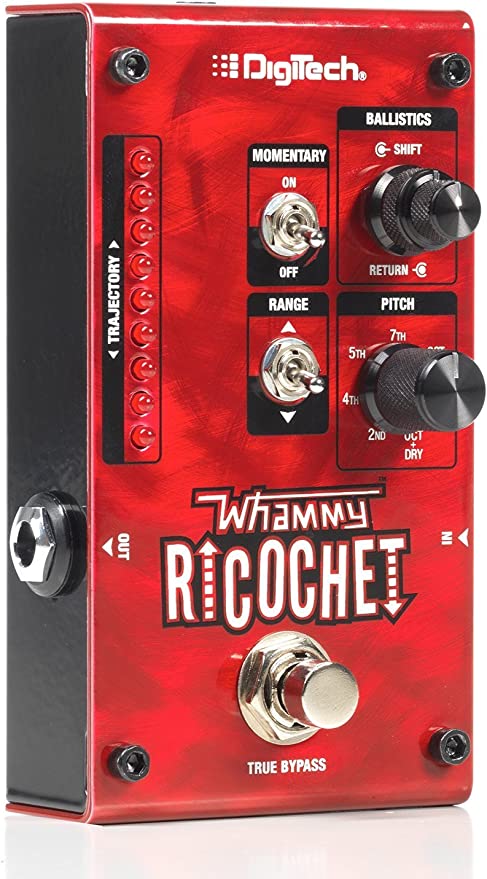
DigiTech’s Whammy Ricochet Pitch Shifting Guitar Effects Pedal is an innovative musical tool that lets guitar players easily alter their pitch while playing.
With a compact design, the pedal has seven pitch options, including the 2nd, 4th, 5th, 7th, octave, double octave, and octave dry.
In addition, guitarists can toggle up and down for their selected pitch, making it quite versatile.
Its momentary switch sets the Whammy Ricochet apart, which allows rapid pitch shifts without using a treadle.
Instead, use the footswitch and let the Ricochet do the work.
Additionally, this pedal features customizable independent rise and fall times and a latching footswitch mode, where users can rise or fall to pitch and stay there during their performance.
A visual bonus is the LED ladder, which always displays the shifting trajectory.
The package includes a 9-volt AC adapter power supply by Planet Waves and two Strukture right-angle patch cables – necessities for setting up and powering the pedal.
With the Whammy Ricochet, gear enthusiasts can explore traditional Whammy pitch shifting styles or create fresh sounds.
- My Review
I recently had the pleasure of experimenting with the DigiTech Whammy Ricochet Pitch Shifting Guitar Effects Pedal, and I have to say, it was quite an impressive piece of equipment.
As a compact, user-friendly pedal, I could easily explore unconventional and classic pitch-shifting effects.
My initial impression was that the pedal’s design was quite appealing.
Its red and black color scheme and its conveniently-sized 4.75″ x 2.88″ x 1.75″ dimensions made a great addition to my existing guitar setup.
I also appreciated that it came with a Planet Waves 9V power supply and two Strukture right-angle patch cables, which saved me the hassle of sourcing these accessories separately.
In terms of functionality, the Whammy Ricochet boasted various useful features such as seven pitch selections (2nd, 4th, 5th, 7th, octave, double octave, and octave dry) and the ability to toggle up or down for my chosen pitch.
This range of options allowed me to produce distinctive pitch shifting techniques during my playing sessions.
What stood out the most, however, was the momentary switch feature.
This allowed me to quickly perform pitch shifts without the cumbersome addition of a treadle.
Instead, I pressed the footswitch and let the Ricochet do its magic.
The customizable independent rise and fall times were a bonus, as were the latching footswitch modes, allowing me to concentrate more on my performance than on adjusting pedal settings.
I admit there was a minor flaw – the predetermined amount of pitch-altered sound, in some instances, didn’t offer the flexibility I’d have liked.
Here are the ratings I’ll give to the DigiTech Whammy Ricochet Pitch Shifting Guitar Effects Pedal:
However, despite this slight inconvenience, the DigiTech Whammy Ricochet proved a solid and reliable pedal.
The Whammy Ricochet is worth considering if you’re searching for a pitch shifting effects pedal that packs a powerful punch in a small package.
- Pros:
- Compact, user-friendly design
- Seven pitch selections
- Momentary switch feature
- Cons:
- Predetermined pitch-altered sound
- Limited sound flexibility
- Minor switch issues reported
My final verdict is that the DigiTech Whammy Ricochet Pitch Shifting Guitar Effects Pedal is an excellent mix of versatility, modern features, and innovative pedal design.
Despite minor issues with its pitch-altered sound, it provides great value for guitarists exploring creative pitch shifting techniques while maintaining a compact and user-friendly setup.
MOOER Pitch Step Expression Guitar Pedal
Real-time pitch shifting and harmonizing with MOOER’s pressure sensing technology.
PITCH STEP is a polyphonic pitch shifter and harmonizer expression pedal, offering real-time control and creative sound design possibilities. It features a high-precision sensor and switch for accurate control, making it perfect for guitarists wanting to explore their instrument’s sonic capabilities.
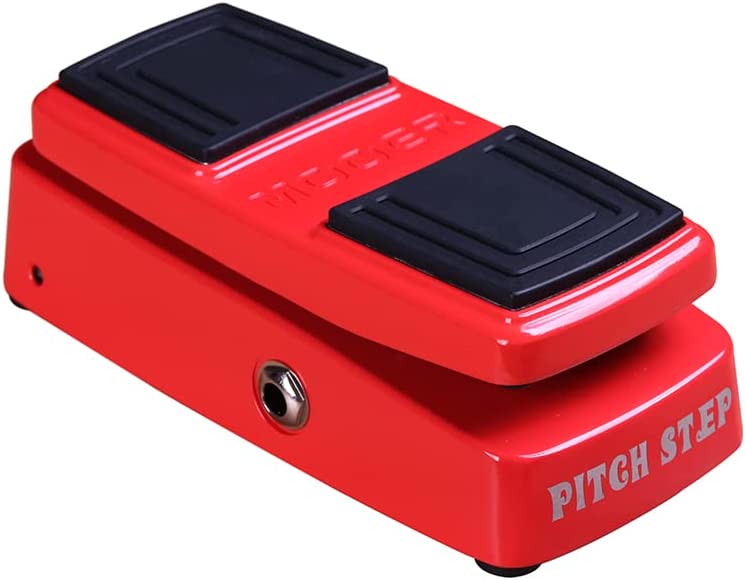
The MOOER Pitch Step Expression Guitar Pedal is a unique and compact polyphonic pitch shifter designed for those who want precise, real-time control over their sound.
This small yet robust pedal offers fast, accurate pitch shifting with an optional dry signal if you prefer natural harmonization.
This versatile pedal lets you personalize the pitch settings ranging from one octave down to one octave up, ensuring it accommodates every player’s needs.
Its adjustable shifting range and direction add to its customizability, providing endless possibilities for crafting your perfect sound.
The MOOER Pitch Step is remarkably efficient, with a 9-volt power supply and a draw of just 300 milliamps.
This pedal also features MOOER’s innovative pressure-sensing technology, delivering an exceptional playing experience for guitarists and bassists.
Its sturdy, stylish, and compact design ensures that not only does it look great on your pedalboard, but it also takes up minimal space.
Crafting harmonies and unique pitch effects has never been easier with this expressive and user-friendly pedal.
- My Review
Having experimented with the MOOER Pitch Step Expression Guitar Pedal, I must say it brings a lot to the table, despite its compact design.
As a polyphonic pitch shifter and harmonizer, it offers rapid and accurate control over my sound when tweaking the settings during performances.
In addition, theluding a dry signal is a noteworthy feature, ensuring the added harmonies complement the guitar’s natural tone.
I appreciate the extent to which the pedal can be customized for pitch control, allowing me to set it anywhere between an octave higher or lower.
This comes in handy when I’m trying to achieve the perfect balance between the preferred pitch and other factors in my music.
The built-in pressure sensing technology is a fantastic innovation by MOOER, transitioning the pedal-switching experience from a standard button to a much more engaging system.
This provides me with extra sensitivity during my playing sessions.
Sleek and stylish, this pedal looks great on my pedalboard, and its compact size saves precious real estate, leaving space for other essential effects units.
Powered by a 9-volt source, its energy efficiency is noteworthy.
However, bear in mind that an external power supply is required, which may affect your board’s design and layout.
One potential drawback of this small pedal is the positioning on the board.
Having enough room for your foot movement; otherwise, you run the risk of accidentally adjusting neighboring pedal settings.
Also worth noting is that a TRS cable is required for this pedal, so have the cable ready or remember to purchase one for maximum effectiveness.
Here are the ratings I’ll give to the MOOER Pitch Step Expression Guitar Pedal:
The MOOER Pitch Step Expression Guitar Pedal is an impressive piece of equipment packed with features, adopting a new standard for pitch shifting on the fly.
While it does come with minor inconveniences, its overall functionality and customizable options outweigh them significantly, making it a valuable addition to the arsenal of experienced and aspiring musicians.
- Pros:
- Polyphonic Pitch-Shifting.
- Supports 9V battery power.
- Compact with pressure sensing technology.
- Cons:
- Power supply sold separately.
- Compact size may cause cluttering issues.
- May require specific cables (TRS).
My final verdict is that the MOOER Pitch Step Expression Guitar Pedal is an outstanding piece of equipment for musicians who want a compact, customizable pedal with impressive pitch shifting abilities.
Its versatile features, pleasantly appealing tones, and overall performance make its few minor inconveniences easily overlooked.
Though the MOOER brand may not be as well-known as some, this pedal is a testament to the innovation they can bring.
With its comparatively great value its unique features, the Pitch Step is worth considering for any musician looking to enhance their sound.
MXR Blue Box Octave Fuzz Pedal
MXR Blue Box™ Octave Fuzz, chaotic and huge subterranean tones.
The MXR Blue Box Octave Fuzz offers a unique and massive sound, blending your guitar signal with two octaves down for an extreme fuzz tone. The Blend knob allows you to control the mix, giving you an unparalleled sonic experience.
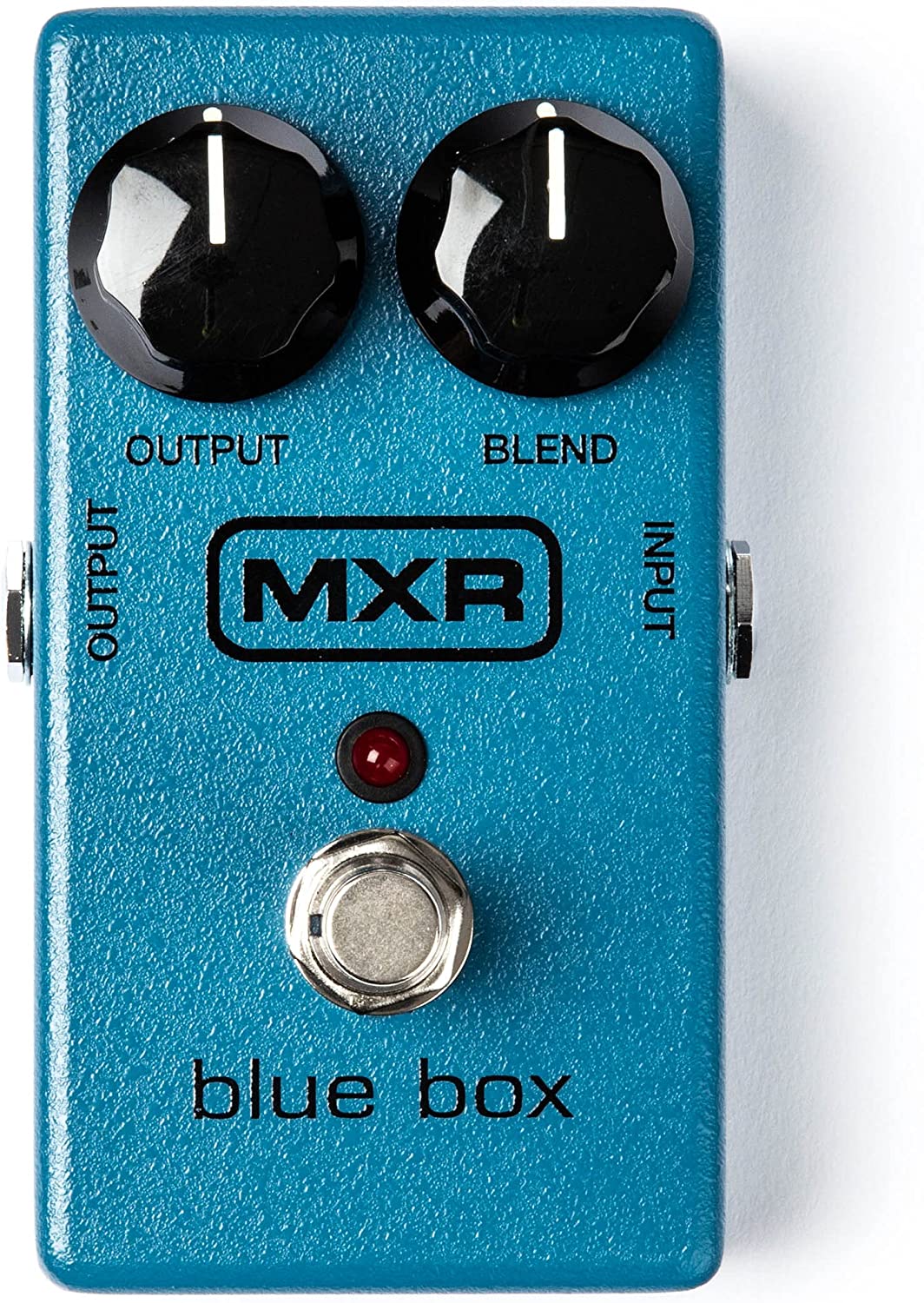
MXR’s Blue Box™ Octave Fuzz is a unique guitar effect pedal designed for musicians who love experimenting with different sounds.
Encased in a compact, durable blue box, this pedal generates an engaging low-frequency output that can cause quite a sonic storm.
The main function of the Blue Box™ is to take your guitar signal, add fuzz to it, and duplicate it two octaves down.
This duplexing results in a massive, subterranean tone perfect for creating a distinct sonic identity.
Being an analog circuitry-powered unit, it possesses quirky profiles that one needs to master to optimize its performance effectively.
This process can be an absolute delight for tone enthusiasts!
The Blue Box Octave Fuzz is known for generating the unconventional effect featured in Jimmy Page’s “Fool in the Rain” solo.
Despite its substantial low-frequency output, it has a blend knob that allows for precise control over fuzz tone mix and two octaves down signal.
Powered by a 9-volt battery or Dunlop’s ECB-003 AC adapter (sold separately), this user-friendly pedal hails from the innovative stables of the revered New York-based effects pedal manufacturer Jim Dunlop.
Explore the countless sonic possibilities the astounding MXR Blue Box™ Octave Fuzz offers!
- My Review
Let me dive into my thoughts on this intriguing little gem, the MXR Blue Box™ Octave Fuzz pedal.
After experimenting with it thoroughly, I found that it delivers an exceptional range of sounds that can take your creativity to new heights.
The core function of taking your guitar signal and duplicating it two octaves down with added fuzz ensures you can recreate iconic tones or blaze new trails through sonic territories.
However, it’s crucial to understand that this pedal isn’t for everyone.
While it offers unparalleled effects for some genres, like blues or desert rock, its limited pitch shifting nature might not appeal to those looking for a fuzz pedal.
On the other hand, if you love to play monophonic licks or embrace unconventional sounds, the Blue Box™ is right up your alley.
Remember, the tracking can make chords sound chaotic or even result in clipping, but these “imperfections” may suit a player more inclined toward experimentation or building noise scapes.
Now, let’s talk about ease of use—analog circuitry enables it to unveil quirky nuances, which can be entertaining but also require mastery to control well.
You might want to spend some time getting to know this pedal inside and out to make every session truly memorable.
One downside I noticed is the significant volume drop when the pedal is engaged.
I suggest running it after an overdrive or using a boost to counter this and get the full potential.
Here are the ratings I’ll give to the MXR Blue Box Octave Fuzz Pedal:
If you’re a musician who wants to delve into bizarre soundscapes, the Blue Box™ Octave Fuzz might be a perfect choice if you accept some of its quirks and limitations.
Embrace its distinctive features, spend adequate time mastering them, and ultimately, this pedal can truly shine, offering moments of unparalleled inspiration.
- Pros:
- Unique octave fuzz tones.
- Ideal for experimental musicians.
- Durable and compact design.
- Cons:
- Significant volume drop.
- Limited pitch shifting.
- May not suit all genres.
My final verdict is that the MXR Blue Box™ Octave Fuzz pedal is an intriguing and unique gear for experimental-minded musicians.
It may offer limited pitch shifting options and show some performance quirks, like the significant volume drop, but if harnessed correctly, it can propel your creativity into new dimensions.
If you’re after unforgettable, characteristic tones, whether for recording or playing live, the Blue Box™ could be the secret ingredient in achieving those distinct sounds.
Red Panda Raster 2 Delay Pedal with Pitch Shifting
Modulate and harmonize delays with Red Panda Raster 2.
Raster 2 is a digital delay with pitch and frequency shifter, allowing for a wide range of sounds including modulated and harmonized delays, chorus, arpeggios, and more. It features two independent delay channels, stereo control, and a soft touch bypass switch for instantly shifting pitch jumps and feedback.
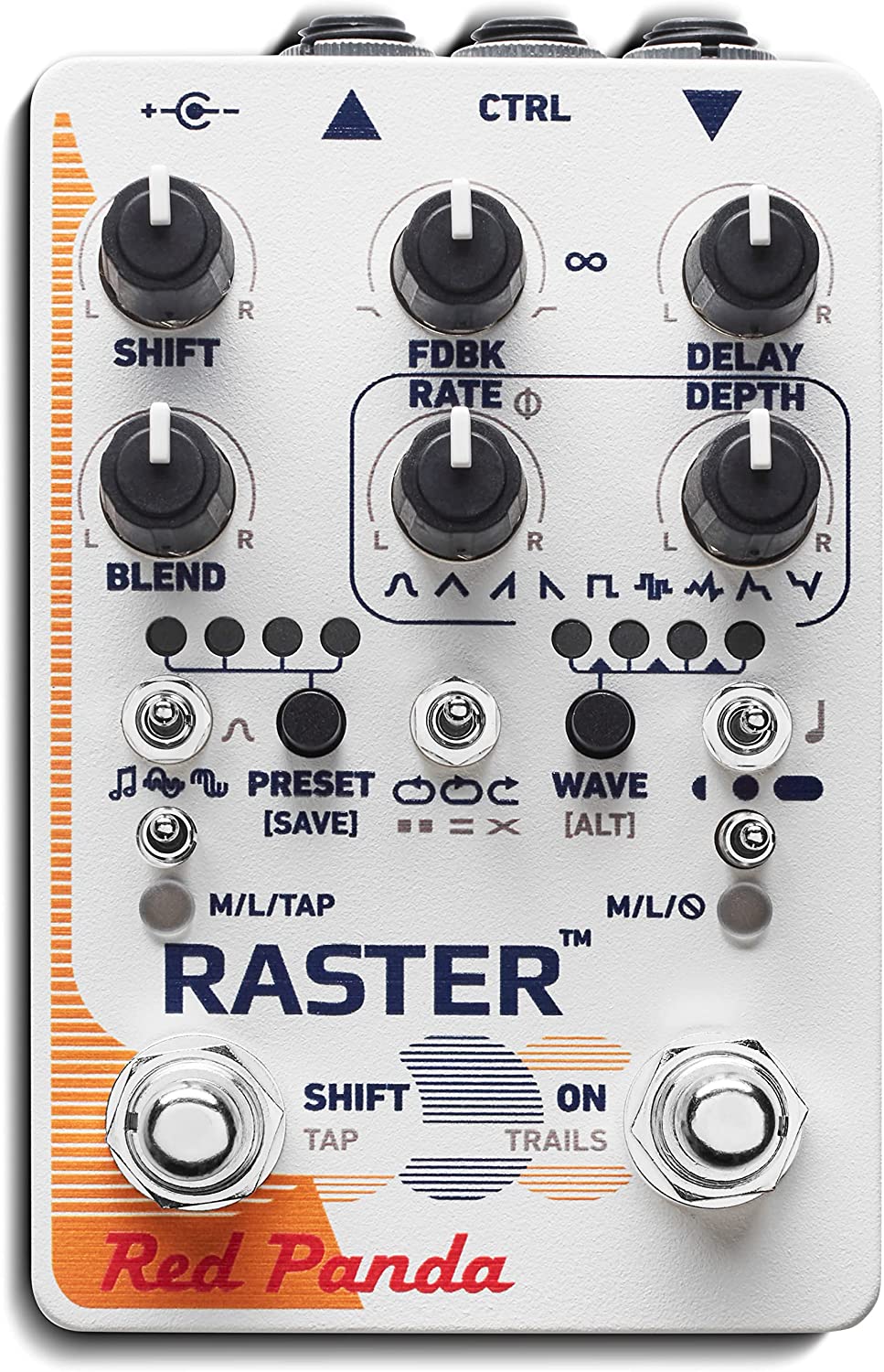
The Red Panda Raster 2 is a unique pedal that combines modulated delay and pitch shifting while delivering high-quality stereo sound.
This versatile effect unit features an impressive 1,600 ms of stereo delay time, which can be finely tuned across three ranges, giving musicians plenty of wiggle room for creative soundscapes.
In addition, with micro pitch shifting offers a wide range of modulated, harmonized, and reverse delays.
An integrated feedback loop and its 7 modulation waveforms make the Raster 2 a highly conducive option for producing novel and experimental effects.
Plus, the onboard phase and frequency shifting capabilities take this pedal’s sound to a new level.
Boasting a stereo input/output and assignable expression pedal or remote switch, this device caters to musicians seeking a versatile tool for performance and recording.
Additionally, with full MIDI implementation and the necessary connectivity options, customizing your sound has never been easier.
Finally, the durable build quality lends a premium look and feels to the Red Panda Raster 2, ensuring it’s well up to the challenge of handling both the hectic pace and high demands of modern music-makers.
- My Review
My experience with the Red Panda Raster 2 Modulated Delay with Pitch Shifting has been extraordinary.
It’s not just a regular delay pedal, it offers far more within its creative boundaries.
The 1,600 ms stereo delay time provided ample room for experimentation and allowed me to dial in multiple captivating delay effects.
In addition, the built-in micro pitch shifting added depth and detail to the soundscape, making it ideal for crafting mesmerizing guitar textures and atmospheric effects.
While exploring the Raster 2’s unique features, I found the 7 modulation waveforms and integrated feedback loop extremely responsive and intuitive, great for uncovering new sonic possibilities.
In addition, the phase and frequency shifting capabilities enriched the overall sound, taking it into the realm of surreal spaces.
I could enjoy complete control over its rich sonic offerings with the device’s stereo input/output and assignable expression pedal or remote switch.
Furthermore, I appreciated the full MIDI implementation, which made it a breeze for me to connect and manipulate settings easily through different mediums.
The Red Panda Raster 2 is for guitarists and any musician who loves to tinker with sound and complexities.
Although the multitude of features and flexibility in this pedal is its strong points, some individuals who prefer simplicity may find the RPL’s wide array of options a tad overwhelming.
However, as someone who relishes the opportunity to push sonic boundaries, I wholeheartedly embraced the experimental nature of this gadget.
Regarding the build quality, this device is well-constructed and features a sleek metallic enclosure with smooth dials for a premium look and feel.
Here are the ratings I’ll give to the Red Panda Raster 2 Delay Pedal with Pitch Shifting:
The Red Panda Raster 2 is a true gem, consistently contributing inspiring and innovative effects to my musical creations.
Suffice to say, it has become an essential part of my pedalboard and sonic explorations.
- Pros:
- Extensive delay and pitch shifting options.
- Fully integrated MIDI implementation.
- Robust build quality and design.
- Cons:
- Potentially overwhelming for some users.
My final verdict is that the Red Panda Raster 2 is an exceptional product for musicians looking to expand their sonic horizons with its extensive features, inviting creativity and experimentation.
The pedal offers impressive versatility, tone, and performance – making it a valuable addition to any pedalboard.
Considering its robust build and ample options for delay and pitch shifting, it is undoubtedly a worthwhile investment for anyone eager to push the boundaries of their sound.
DigiTech DROP Compact Polyphonic Pitch-Shifter Pedal
Polyphonic drop tuning made easy with DigiTech DROP.
The Digitech DROP is a dedicated polyphonic tune pedal that allows you to DROP your tuning from one semitone to an octave. It features a momentary/latching switch for performance effects and is true bypass with a 9V DC power supply.
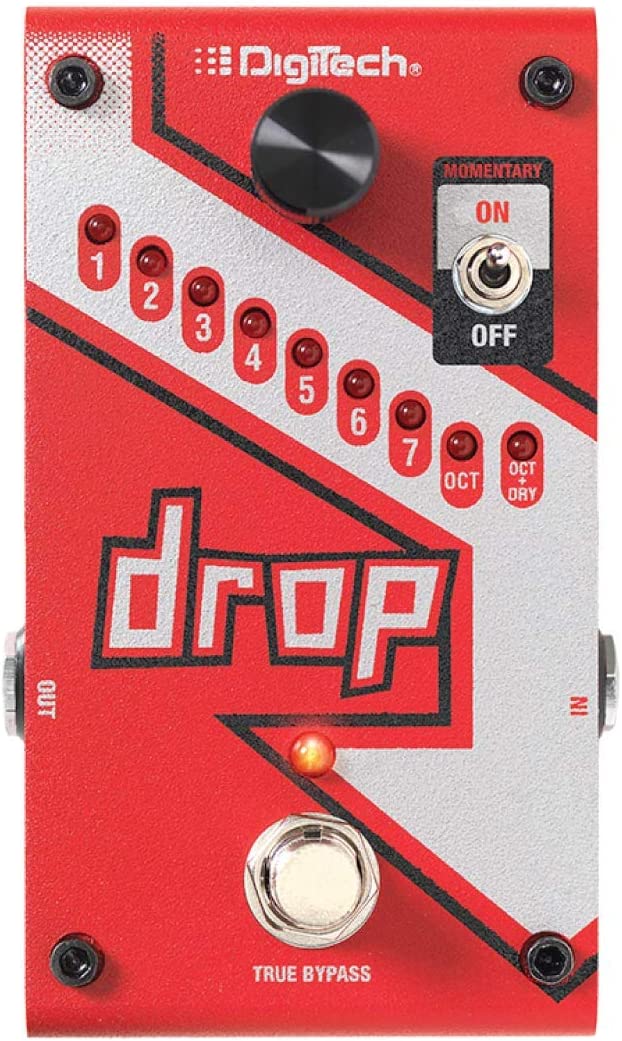
The DigiTech DROP compact polyphonic pitch-shifter pedal is valuable for guitarists and bassists.
This device provides an effortless way to drop-tune an instrument from one semitone down to a full octave, making it possible to achieve deep, down-tuned tones without adjusting the strings’ tuning themselves.
In addition, the DROP pedal features different 33-pitch modes that musicians can explore to find new and innovative sounds.
Among the noteworthy features of this pedal is the option to use it in either momentary or latching mode, giving users control over how long the effect stays active.
In addition, this pedal operates with true bypass, ensuring that the quality of your guitar’s natural tone is maintained when not in use.
Meanwhile, the included 9VDC power supply integrates seamlessly with your existing pedalboard.
The compact red pedal is designed to effectively deal with gigging and studio use, boasting dimensions of 4.75 x 2.88 x 1.75 inches and weighing just one pound.
- My Review
I had the opportunity to try out the DigiTech DROP compact polyphonic pitch shifter pedal and was thoroughly impressed.
This useful gear is ideal for guitarists and bassists who want to easily switch between various tunings without the hassle and time involved with manually tuning their instruments.
With the ability to shift pitch from one semitone to a full octave, this pedal is a game-changer.
The DROP pedal offers 33 pitch modes, which I loved experimenting with to discover new sounds and enhance my creative process.
One of the standout features for me was the ability to switch between momentary and latching modes, giving me complete control throughout the effect with just a click of the footswitch.
This pedal does an excellent job of preserving the original tone through true bypass functionality.
I maintained the natural sound of my guitar even when the effect was disengaged.
The included 9VDC power supply allows for easy integration with other pedalboard components.
Its compact size — measuring just 4.75 x 2.88 x 1.75 inches and weighing only one pound — makes it effortlessly portable and perfect for tight pedal setups.
While I found the pedal incredibly useful and effective, I noticed some minor drawbacks.
For example, at low volumes, the blend of the physically played string sound and the digitally altered sound from your amp may seem dissonant to some listeners.
Here are the ratings I’ll give to the DigiTech DROP Compact Polyphonic Pitch-Shifter Pedal:
Additionally, I detected a subtle latency in the pedal’s performance when playing fast riffs with sharp attacks.
Nevertheless, the DigiTech DROP pitch-shifter pedal is undoubtedly a remarkable and innovative tool well-suited to guitarists and bassists seeking to expand their sonic arsenal without lugging multiple instruments for gigs and recordings, saving time and energy.
- Pros:
- Effortless pitch-shifting capabilities.
- 33 versatile pitch modes.
- True bypass preserves tone.
- Cons:
- Latency in fast riffs.
- Dissonance at low volumes.
- Limited option for pitch upshifts.
My final verdict is that the DigiTech DROP compact polyphonic pitch-shifter pedal is a highly valuable addition to any guitarist or bassist’s rig.
Its versatility, wide range of pitch shifting options, and true bypass for preserving tone make it an impressive tool for musicians seeking creative flexibility.
Despite some minor issues in performance, especially at low volumes, the pedal stands out for its overall quality and brand reputation.
Considering the convenience, features, and value that this pedal brings to the table, it is well worth considering for those looking to enhance their sonic palate.
What exactly is a pitch shifting pedal?
A pitch shifting pedal, sometimes referred to as a pitch shifter or harmonizer, is an audio effects pedal designed to alter or adjust the pitch of an input signal – typically from a musical instrument or voice – to a new, desired pitch.
The main purpose of this device is to create harmonies, thicken chords, or produce creative and unique effects that would be difficult or impossible to achieve through regular playing techniques.
Designed primarily for use with guitars, pitch shifting pedals are widely utilized by musicians in a variety of genres to enhance the tonal characteristics of their music.

However, appropriate input and output connections can also be used with other instruments, such as synthesizers, keyboards, bass guitars, and even vocals.
The basic concept behind pitch shifting technology dates back to the early days of electronic music.
Analog pitch shifters use electronic components to modulate the frequency of an audio signal, either up or down, to create the desired effect.
This technology was eventually replaced by digital processing, dramatically increasing pitch-shifting pedals’ accuracy and versatility.
Modern pitch shifting pedals use digital signal processing (DSP) technology to analyze and manipulate the input signal’s frequency spectrum.
The algorithm within the pedal’s processor first converts the analog waveform into a digital representation and then performs a Fourier Transform, which separates the signal into its various frequency components.
The processor then shifts each frequency component according to the desired pitch change while typically maintaining the original signal’s timing and phase relationships.
Finally, the altered components are combined, and the processor converts the digital signal back into an analog waveform for output.
There are two primary types of pitch-shifting effects: pitch transposition and intelligent harmonization.
Pitch transposition shifts the input signal’s entire frequency content by a fixed interval, preserving its harmonic structure.
This effect can shift a guitar’s tuning, simulate a 12-string guitar, or create a detuned doubling effect.
Most pitch-shifting pedals offer a range of transposition options, from subtle detuning to varying intervals of whole octaves.
On the other hand, intelligent harmonization alters the input signal’s pitch based on a specific musical key and scale, generating harmonies that are musically relevant to the original melody.
This effect is especially popular among guitarists, as it can create the illusion of multiple layered guitars playing in harmony, even when a single musician is performing.
In addition, many pitch shifting pedals have built-in settings for different keys and scales, allowing users to select the desired harmony intervals.
In addition to these core effects, modern pitch shifting pedals often include additional processing options, such as time-stretching, vibrato, chorus, delay, and reverb.
Some high-end pitch shifting pedals also provide multi-voice harmonization capabilities, which allow for the simultaneous generation of multiple harmonies on a single input signal.
This results in richer, more complex harmonies and creates a broader range of creative possibilities for musicians.
Pitch shifting pedals vary in terms of their capabilities, tones, and features.
Some pedals are designed to be easy to use, with straightforward controls and user-friendly interfaces.
In contrast, others offer many deep customization options for advanced users and experimental musicians.
Some pitch shifting pedals prioritize accuracy and high-quality audio processing, while others prioritize a lo-fi or “analog” sound reminiscent of earlier pitch shifting technology.
What to consider when choosing a pitch shifting pedal?
When choosing a pitch-shifting pedal, several factors should be considered to ensure that you invest in one that best suits your needs and preferences as a musician.
The following aspects are essential to consider and evaluate before making a decision.
– Sound quality
Sound quality is the primary concern when selecting any effects pedal, including a pitch-shifter.
Looking for a pedal that delivers a clear, articulate, and natural-sounding pitch shift is essential.
Please pay attention to the accuracy of the harmonies generated and ensure they are without unwanted artifacts or dissonance.
High-quality audio processing is often attributed to advanced digital signal processing (DSP) technology; however, some users may prefer a more “analog” sound reminiscent of earlier pitch shifting technology for a distinct charm.
Be sure to test a pitch shifter with your instrument and amp, which can greatly impact the perceived sound quality.
– Controls and features
The range of available controls and features on a pitch-shifting pedal can significantly impact its usefulness and versatility.
Consider a pedal with easy-to-use, intuitive controls for essential parameters such as pitch shift amount, harmony interval, and input/output levels.
More advanced pedals may include custom key and scale settings, multiple harmony voices, and additional effects like time-stretching, vibrato, chorus, or delay.
Determine which features are important to you and your preferences, and ensure the pedal meets those requirements.
– Analog vs. Digital
The debate between analog and digital pitch shifting technology often comes to personal taste.
Analog pitch shifters use electronic components to modulate the frequency of the input audio signal, providing a warm and classic character that some musicians appreciate.
In contrast, digital pitch shifters rely on advanced algorithms and DSP to analyze and alter the audio signal.
While digital pedals often provide greater accuracy, features, and sound quality, some users may prefer analog devices’ unique charm and warmth.
Ultimately, the choice between analog and digital depends on your preferences and priorities.
– Build quality and durability

A pitch shifting pedal should be built to withstand the rigors of live performances and regular use.
Consider pedals with sturdy, high-quality enclosures, reliable footswitches, and durable knobs and jacks.
A robust pedal will perform better in the long run, saving you from unnecessary maintenance or replacements.
– Presets and versatility
Having a wide range of presets and the ability to store your settings can be a valuable asset in a pitch-shifting pedal.
This allows you to recall specific harmonies, scale settings, or pitch shifting configurations quickly, which can be especially helpful in live performance situations.
In addition, versatile pedals with numerous preset and a wide array of features such as multi-voice harmonization, adjustable pitch intervals, and additional effects can open new creative possibilities.
– Brand reputation

When selecting a pitch shifting pedal, it’s important to consider the manufacturer’s reputation.
Brands with a history of producing high-quality, reliable, and innovative pedals can often be a better bet than lesser-known or inexperienced manufacturers.
In addition, top manufacturers are more likely to provide robust customer support, quality assurance, and a track record of satisfied users.
Research the reputation of various brands and read forums, product reviews, and testimonials from musicians with experience with their products.
– Price and budget
Pitch shifting pedals are available at varying prices to suit musicians with different budgets.
While more expensive pedals often come with advanced features and higher sound quality, budget-friendly options offer reasonable performance at a lower cost.
Set a budget for yourself and evaluate the available options within your price range.
Remember that investing in a more expensive, high-quality pedal may save you money in the long run by avoiding upgrades or replacements.
– Reviews and recommendations
Finally, it’s important to research and seeks reviews and recommendations from other musicians, professional reviewers, and trusted sources.
Read product reviews in guitar and music magazines, online forums, and retailer websites.
Watch demo videos on platforms like YouTube to understand how the pedal performs and sounds with different instruments and setups.
Reach out to fellow musicians or local music stores for recommendations and insights based on their experiences.
How to properly use a pitch shifting pedal?
A pitch shifting pedal is a powerful tool that can transform your sound by altering the pitch of your instrument or voice, creating harmonies, or generating unique effects.
However, to make the most of this versatile device, it is essential to use it properly.
The following steps provide a comprehensive guide on maximizing the potential of your pitch shifting pedal and enhancing your musical performance.
– Familiarize yourself with the controls and features:
The first step in properly using a pitch shifting pedal is understanding its various controls and features, as each pedal may offer different capabilities.
Begin by exploring the knobs, buttons, and switches on the pedal and consult the user manual for an in-depth explanation of their functions.
Common controls typically include pitch shift amount, harmony interval, input/output levels, and, in some cases, key and scale settings.
Familiarizing yourself with these controls and their functions will provide a solid foundation for creating your desired sound.
– Adjust the parameters to suit your musical goals
Once acquainted with the controls and features, experiment with adjusting the parameters to achieve your musical objectives.
For instance, if you wish to create harmony in a specific key, configure the key and scale settings accordingly, then adjust the pitch shift amount or harmony interval to obtain the desired effect.
The pedal can be tailored to your creative vision and musical goals by carefully tweaking these parameters.
– Incorporate the pitch shifting pedal into your signal chain
The placement of your pitch shifting pedal in your signal chain is crucial in determining its overall sound and effectiveness.
While there are no strict rules in determining pedal order, most pitch-shifters benefit from a clean input signal, which means they should be placed early in the chain.
This is particularly true when pitch shifters with other distortion or modulation effects may introduce artifacts or noise into the signal.
Additionally, it’s important to experiment with different signal chain configurations to find the setup that delivers the desired sound and performance.
– Test the pedal in various performance settings
Having configured the pitch shifting pedal according to your desired sound and musical goals, it is essential to test it in various performance environments.
For example, practice playing in a rehearsal space, recording in a studio, or performing live, as different settings may interact differently with your pedal and influence the output sound.
By testing your pedal in multiple scenarios, you’ll understand how to optimize the pedal for each situation and be more versatile and adaptable when making adjustments on the fly.
– Experiment with different musical styles and applications
Pitch shifting pedals offer various creative possibilities, making them suitable for various musical styles and applications.
Experiment with using the pedal in different genres and playing techniques to discover new ways to use its capabilities.
For example, use the pedal to create harmonies for a rock ballad, simulate a 12-string guitar sound in a folk song, or detune your guitar for a heavy metal riff.
Pushing the pedal’s boundaries can lead to discovering unique sonic textures and expanding your musical vocabulary.
– Combine the pitch shifter with other effect pedals
Amplify your sound further by integrating your pitch shifting pedal with other effects pedals.
Using the pitch shifter alongside overdrive, distortion, modulation, or time-based effects can produce exciting and intricate sounds that can take your musical performance to new heights.
For example, blend harmonies generated by the pitch shifting pedal with a lush reverb for added depth and dimension or send pitch shifted signals to a delay pedal for complex, multi-layered echoes.
Don’t hesitate to experiment with different signal chains and combinations of effects, as this can help you find the ideal sound that complements your playing style.
– Refine your pitch shifting technique
Mastering a pitch shifting pedal requires ongoing practice, fine-tuning, and experimentation.
Revisit the pedal’s settings periodically, adjust parameters, and refine your performance technique to improve the sound and usability of the pitch shifting pedal.
Stay informed about advancements in pitch-shifting technology and engage with other musicians in online forums and discussion groups to learn from their experiences.
Greater knowledge and proficiency with the pitch shifting pedal will empower you to unleash its full capabilities and develop your signature sound.
How to order pedals on a pedalboard?
There is no one-size-fits-all approach to ordering pedals on a pedalboard, as the optimal arrangement largely depends on the specific sound you’re aiming for.
Usually, though, you will see guitar players mostly agreeing with this order:
Tuner > Filters/Dynamics > Pitch-based Effects > Overdrive/Distortion > Modulation > Time-based Effects > Looper
Aside from that, some general guidelines can help you achieve a balanced and versatile setup.
Let’s talk in detail about the order we just mentioned, but feel free to experiment and adjust to your own preferences:
- Tuner: Place your tuner pedal first to ensure your signal is in tune before passing through the other pedals.
- Filters and dynamics: Wah-wah, envelope filters, compressors, EQs, and noise gates should come next. These pedals affect your sound’s dynamic and tonal aspects, so it’s best to place them early in the chain.
- Pitch-based effects: Octavers, harmonizers, and pitch shifters should come after filters and dynamics since these pedals alter the pitch of your signal and work best with a clean, unprocessed sound.
- Overdrive and distortion: Overdrive, distortion, and fuzz pedals typically come next. They shape your guitar’s core sound, and placing them before most other effects ensures that those effects receive a strong, consistent signal.
- Modulation effects: Chorus, flanger, phaser, and tremolo pedals should be placed after overdrive and distortion effects. We do this to allow these pedals to add depth and movement to your sound without becoming overly distorted or overbearing.
- Time-based effects: Delay and reverb pedals should be placed towards the end of your signal chain. This allows them to create a sense of space and depth around the other effects, simulating the sound of a room or hall.
- Looper: If you use a looper pedal, it should be placed last in the chain. This ensures that you’re looping the entire signal, including all the effects you’ve applied.
Remember, these are just general guidelines and what generally works and sounds good.
The most important thing is to experiment and find the arrangement that best suits your personal sound and style.
For example, here’s one pedalboard signal chain that I always use:
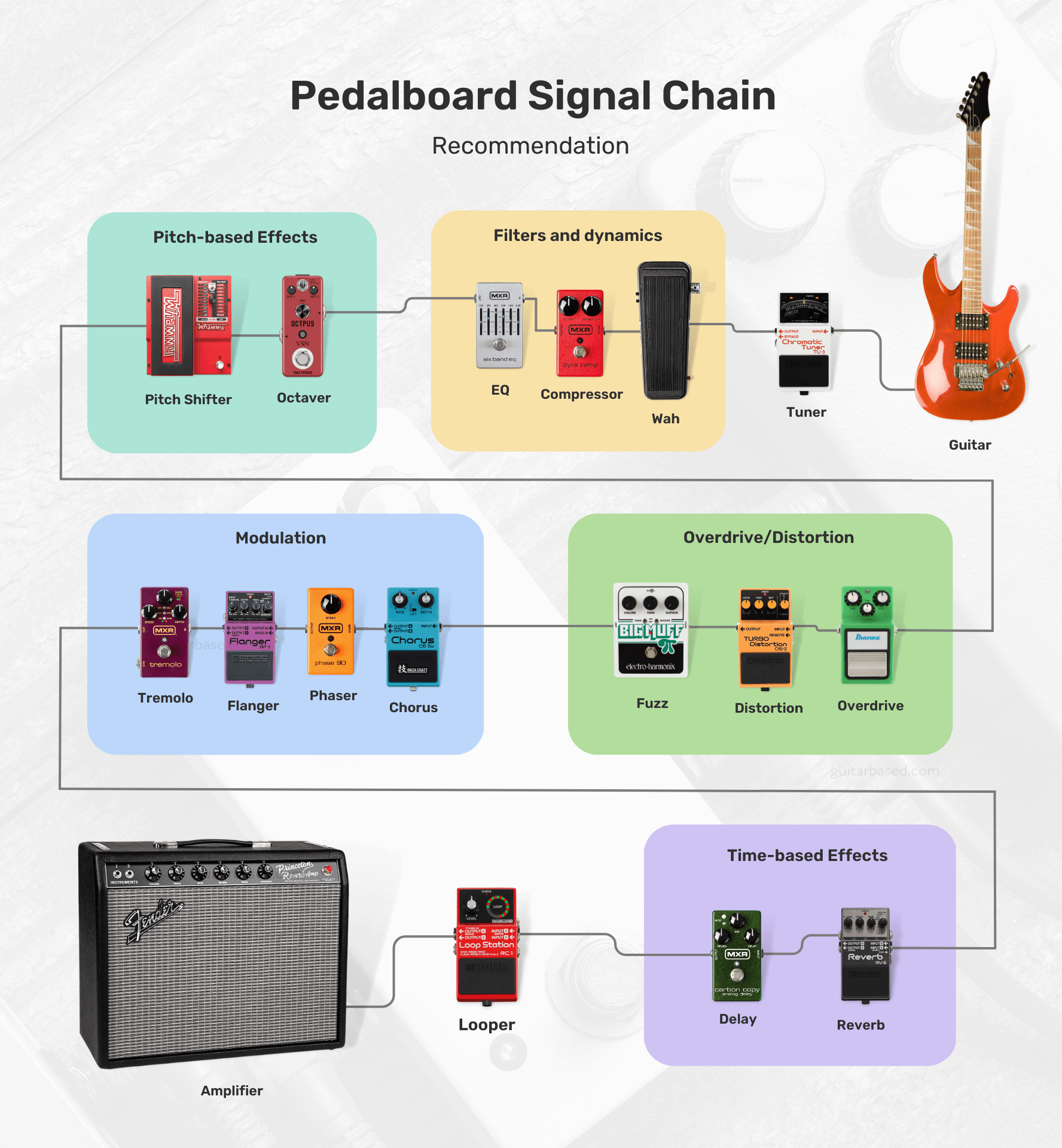
Feel free to swap the order of pedals, try different combinations, and test out unconventional setups until you find the one that works best for you.
For those interested, I’ll leave you with most of the possibilities that you’ll encounter and how to order them.
- Tuner
- Filters/Dynamics:
- Volume
- Wah
- Auto-Wah
- Compressor
- Noise Gate
- EQ (Equalizer)
- Pitch-based Effects:
- Octaver
- Harmonizer
- Pitch Shifter
- Overdrive/Distortion/Fuzz:
- Boost
- Overdrive
- Distortion
- Fuzz
- Modulation:
- Chorus
- Phaser
- Flanger
- Univibe
- Vibrato
- Tremolo
- Time-based Effects:
- Delay
- Echo
- Reverb
- Synth/Bitcrusher:
- Synth
- Bitcrusher
- Acoustic Simulator
- Multi-Effects
- Utility:
- Buffer
- A/B/Y Switcher
- MIDI Controllers
- Looper
Boutique vs. Mass-Produced pedals
Boutique pedals are generally built with higher-quality components and craftsmanship, resulting in better durability and longevity.
These pedals often feature unique and innovative designs, providing a wider range of tones and effects that may not be available in mass-produced options.
Here are a few examples of boutique pedals:

All the manufacturers also tend to have a more personal approach, with better customer service and the ability to customize pedals according to the user’s preferences.
However, boutique pedals are usually more expensive due to the smaller scale of production and the use of premium components.
Mass-produced pedals, on the other hand, are more affordable due to their larger scale of production and the use of cost-effective components.
These pedals are widely available and offer a range of popular effects, making them accessible to a larger audience.
Here are a few examples of mass-produced pedals:

The quality control for mass-produced pedals can vary depending on the brand and model, but many are reliable and offer good value for the money.
As for one of the downsides, you’ll find that mass-produced pedals may not have the same level of uniqueness or innovation as boutique options.
On the other hand, they may not provide the same level of customer service or customization options.
The choice between boutique and mass-produced pedals depends on your personal preferences, budget, and desired sound.
If you’re looking for unique tones, higher-quality components, and a more personal experience, boutique pedals may be the way to go.
But I would say, for those who are on a budget and need access to popular effects, mass-produced pedals might be a better fit.
It’s worth trying out both types to see which best suits your needs and playing style.
How much should you spend on a guitar pedal?
If I were in your position, I would first determine my budget and specific needs before deciding how much to spend on a guitar pedal.
For beginners, it might be more reasonable to start with affordable, mass-produced pedals to explore different effects without spending too much.
Guitar pedals can range in price from around $30 to over $400, depending on the brand, quality, and complexity of the effect.
As your skills and understanding of your preferred tone develop, you can gradually upgrade to higher-quality or boutique pedals.
One thing I would do is consider which effects are essential to your playing style and prioritize purchasing those first.
Allocating a larger portion of your budget to the most important pedals might be a wise choice, especially if you only need a few basic effects.
However, if you require a wide array of effects, you may want to consider more budget-friendly options or multi-effects units.
Keep in mind that higher-priced pedals often come with better build quality, unique features, and improved sound quality.
But I would also say that price is not always directly correlated with quality or suitability for your needs.
Sometimes, a more affordable pedal can deliver the exact sound you’re looking for, while a higher-priced option might not meet your expectations and are only expensive because of the brand reputation.
Can you use a guitar pedal with a bass guitar?
You can certainly use a guitar pedal with a bass guitar.
But it’s crucial to be aware that some guitar pedals may not be specifically designed to accommodate the frequency range of a bass guitar.
This could result in a less-than-ideal performance or an altered tone that might not be what you were expecting.
If you’re feeling adventurous and eager to experiment with your sound, don’t hesitate to connect your guitar pedals to your bass guitar.
This can be a fun way to explore different sonic possibilities, and you might even stumble upon some unique tones that complement your playing style perfectly.
Using a guitar pedal with a bass guitar may not always produce the desired results.
In some cases, the low-end frequencies might be lost, or the effect could sound too harsh or muddy.
To avoid these issues, you could consider looking into pedals that are specifically designed for bass guitars.
These pedals are engineered with the bass frequency range in mind, ensuring that your low-end remains intact and the effect sounds as intended.
In addition to bass-specific pedals, there are also multi-effects processors and pedals that cater to both guitar and bass players, offering a wide range of effects and tonal options.
These versatile units can be a great solution if you play both instruments and want a single device to cover your needs.
How to properly power your pedals?
When it comes to powering your pedals, you want to make sure you’re doing it right to avoid any noise issues or potential damage.
First, check each pedal’s power requirements, which you can usually find in the manual or on the pedal itself.
You’ll want to pay attention to the voltage (usually 9V, 12V, or 18V) and current (measured in milliamps or mA).
Now, you’ve got a few options for powering your pedals.
You can use individual power supplies or batteries for each pedal, but that can get messy and inconvenient.
I’d recommend going for a pedal power supply or an isolated power brick.

For example here are a few ones I recommend:
- Voodoo Lab Pedal Power 2 Plus Isolated Power Supply (My favorite)
- Rowin PW-1 Guitar Pedal Power Supply (Cheapest)
These babies can power multiple pedals at once, and the isolated outputs help prevent noise and ground loop issues.
Just make sure the power supply you choose can handle the voltage and current requirements of all your pedals.
When you’re connecting everything, use good quality power cables and keep them neat and tidy to avoid a tangled mess.
You might even want to use cable ties or cable organizers to keep everything in order.
In love with guitars, and gear; expert in all things music! Been writing about guitars for about 5 years and counting. Born in the ’90s. Alma Mater: University of Havana. Always curious, trying to understand the world. #TeamFender

